new posts in all blogs
Viewing Blog: Frogs Are Green, Most Recent at Top
Results 51 - 75 of 295
Helping to bring awareness about the worldwide decline of frogs and other amphibians
Statistics for Frogs Are Green
Number of Readers that added this blog to their MyJacketFlap: 1
By: frogs are green,
on 9/27/2014
Blog:
Frogs Are Green
(
Login to Add to MyJacketFlap)
JacketFlap tags:
biodiversity,
Learn about Frogs,
Children and Nature,
Frog People,
Read about Frogs,
Frogs as Pets,
Toad Conservation,
chytrid fungus,
Chytrid disease,
Teaching Kids about Frogs,
Amphibian research,
A-Z Frogs,
Batrachochytrium dendrobatidis,
amphibians in home,
captive bred,
fire-bellied toads,
kids with frogs,
Add a tag
Recently I’ve been meeting children at my Frogs Are Green table at various Jersey City events and this one young girl told me she had at home: fire-bellied toads, a lizard, fish, 2 dogs and her brother had turtles too.
Growing up my parents weren’t so keen on animals in the home and perhaps that’s why I love wildlife so much, watch nature programs, and have my own pets. Over the years I’ve had fish, turtles, and cats.
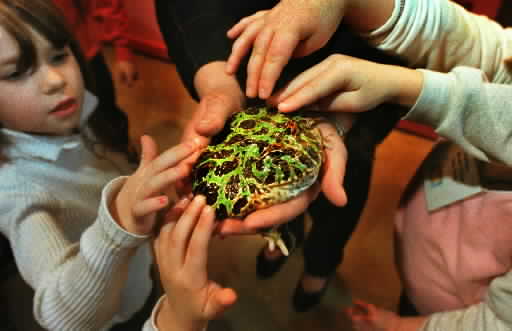
It got me thinking about all that variety from someone so young, and whether it’s a good idea for a child to be responsible for so many pets. In addition, I was quite surprised to hear she had frogs. At first I thought she was joking with me. But a few days later, I heard from another young boy that he also had fire-bellied-toads at home.
It’s not something I recommend because there are so many issues right now with frogs potentially carrying the chytrid fungus (Batrachochytrium dendrobatidis) disease and if those frogs were let go or escaped into an area unnatural to them, they would be helping spread the disease.
(To learn more about this, Save The Frogs has a great web page on this:
Chytrid Fungus in the Pet Trade
“As the trade of amphibians is highly unregulated, disease testing of amphibians traveling between countries and states is next to none. Many amphibians that travel often are carries of the chytrid fungus, which is greatly responsible for the amphibian declines around the world. Approximately 300 species have been detected with chytrid and it is now present in nearly 40 countries. In 2011, a study found that in many pet shops and pet expos nearly 3% of the captive amphibians tested positive for the presence of chytrid, and 13.6% of the collections yielded at least one positive result.” — from Save the Frogs
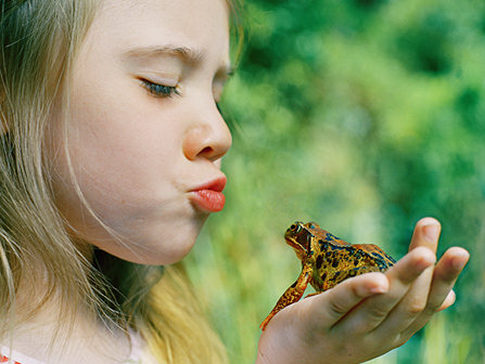
Frogs As Pets
I decided to look further into how common it is for kids to have pet frogs and found this informational web page: “Your First Frog.”
It’s obvious from reading this page how complex taking care of a pet frog would be. Once you finish this page, I’m sure you’ll agree they belong in the wild.
Only those that are threatened with extinction and are being helped by scientists/herpetologists in captivity like the Golden Mantella, or those doing important research to help amphibians, should have them away from their natural habitats.
___________________________________________________________________
Here are some thoughts on this topic from David Veljacic, nature and wildlife conservationist…
When deciding to buy a child a pet there some questions to keep in mind.
Is my child responsible enough to care for a pet? Never buy children pets to teach them responsibility.
Is this interest a fad?
What is my child looking for in a pet? Does Your child want a playmate or a piece of nature?
Do I have the space?
Does my child have the time? With kids enrolled in so many activities they simply may not have the time to care for the animal properly. Ultimately, the parents have the responsibility to pick up the slack that the kids may leave.
Can we afford the upkeep?
And, if looking at exotics – Is it captive bred? Only buy captive bred animals.
Once You have decided to let Your child have a pet, You need to educate Yourself on the needs of the animal You are buying. You may be called upon to care for the animal from time to time. It is also good, particularly with young kids, to check up on the pets to make sure things are going well, so You should know a little about it.
I have seen it happen many times with people who keep exotics, particularly reptiles and amphibians, where it becomes an obsession to buy more and more species. There is always a new color morph or new species available, and it can be very tempting. I recommend not growing a collection too quickly, a child can become overwhelmed before they know it.
Do Your research! NEVER include pet store workers opinions in Your research! Pet store workers are there to sell You things, then sell You more things. You need have the type of animal You plan on buying researched before heading to the pet store, or breeder, and the only questions left should be things like…
Is the animal captive bred?
Is the animal eating/pooping properly?
You should also be allowed to inspect the animal for obvious injuries.
Many exotics that in the past were sold as “disposable” live for years, even decades. If You cannot commit to a long lived animal, don’t buy one. Never release captive animals into the wild.

By: frogs are green,
on 9/11/2014
Blog:
Frogs Are Green
(
Login to Add to MyJacketFlap)
JacketFlap tags:
Learn about Frogs,
frog calls,
Frog People,
Frog and Toad Migration,
Creating a Wildlife Friendly Backyard,
Frogs and Insects,
chirping and croaking of frogs,
frogs and toads in winter,
grey tree frogs,
indoor garden and frogs,
Jack Stearns,
Massachusetts frogs and toads,
rescuing bullfrogs,
solarium and frogs,
Add a tag
The story continues with Jack Stearns, a scientist and meteorologist in Massachusetts, who had rescued a Bullfrog (Bartholomew) last Winter, updates us on his progress along with a discovery of Grey Tree Frogs in the area.
Bart must be happy back in his pond as my wife hears deep croaking when she walks by the pond at lunch time. It has to be Bart! Also seen has been a big bullfrog near the spot where we let him go and he makes quite a splash when he jumps into the pond.
Another story involves a Gray Tree Frog. My wife works as a receptionist and is located in a huge lobby which has a big indoor garden, complete with trees and many plants. A couple of years ago a Gray Tree Frog got in and took up residence and proceeded to serenade the guards at night. It took them months to figure out what the noise was since the chirping resonates in the big lobby. He only hibernated for two months and came out in February to start singing again. It was weird to see snow falling and hearing this frog chirp. In fact, that was his name, Chirp.
He disappeared in the spring and we figure he got out the same way he got in, under the door that is right by the indoor garden.
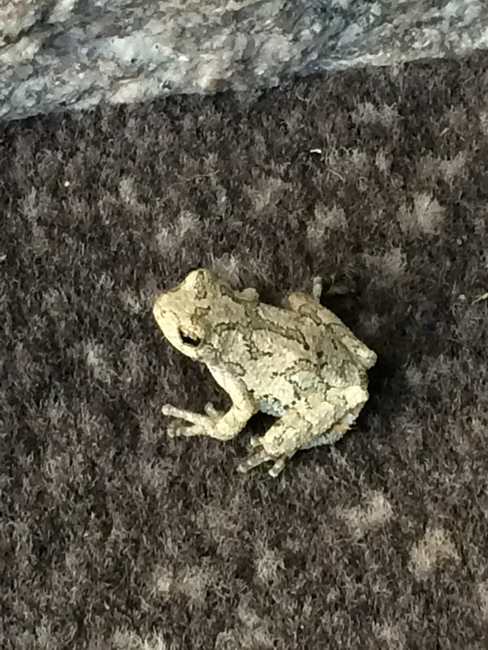
Well it looks like history is repeating itself. Above is a picture of a very young tree frog who got into the lobby. After this picture was taken he proceeded to scurry up the wall behind him into the indoor garden. Apparently a few others have been seen entering as well, especially at night. No noise yet, but I figure that by early spring there will be another chorus of tree frogs in the solarium. There is plenty for them to eat as they have been observed close to the outdoor window, snagging bugs that land there.
The frog population may be declining but not around where my wife works. The underground garage has lots of toads in the summer season who know that bugs are attracted by the lights and the toads come in for a quick meal. Everyone is careful of the toads when walking around the garage and there have been very few fatalities.
— Jack Stearns
By: frogs are green,
on 9/2/2014
Blog:
Frogs Are Green
(
Login to Add to MyJacketFlap)
JacketFlap tags:
Hawaii,
biodiversity,
CHIRP,
Learn about Frogs,
coqui Puerto Rico,
How You Can Help,
Children and Nature,
Environmental Health,
Frog Conservation,
People Helping Frogs and Toads,
Chemicals in the Environment,
Frog People,
Amphibian habitat loss,
Invasive Species,
Creating a Wildlife Friendly Backyard,
Teaching Kids about Frogs,
frogs and Hawaii,
hawaiian coqui,
A-Z Frogs,
wildlife conservation,
Frogs and Insects,
citric acid,
Coqui Hawaiian Integration and Reeducation Project,
coqui tree frog,
Good Shepard Foundation,
Hawaiian Government and Coqui frogs,
Sydney Ross Singer,
Add a tag
I received yet another call from someone distressed about coqui tree frogs on her property. No, she wasn’t wanting to find out how to kill the frogs. She was trying to find out how to keep them and resist aggressive neighbors wanting the frogs destroyed.
For many people in Hawaii, as in Puerto Rico, the coqui frog is considered an adorable creature, singing at night and improving the environment by eating insect pests. They can get loud in large numbers, but for those who enjoy the sounds of wildlife, the coqui chirp is soothing and creates a white noise that aids sleep.
However, the Hawaiian government has passed laws to vilify coqui frogs as a noisy environmental menace, making it illegal to “harbor” or transport coquis within the state. According to the law, coquis frogs are pests by definition, and anyone enjoying them does so at his own peril. Millions of dollars have been spent trying to stop the spread of the frogs, which now reside happily on the Big Island’s east side and in limited areas of the other islands.
Of course, if the coqui frogs were native to Hawaii, they would be protected, not killed. The sound would be appreciated and promoted, as it is in Puerto Rico.
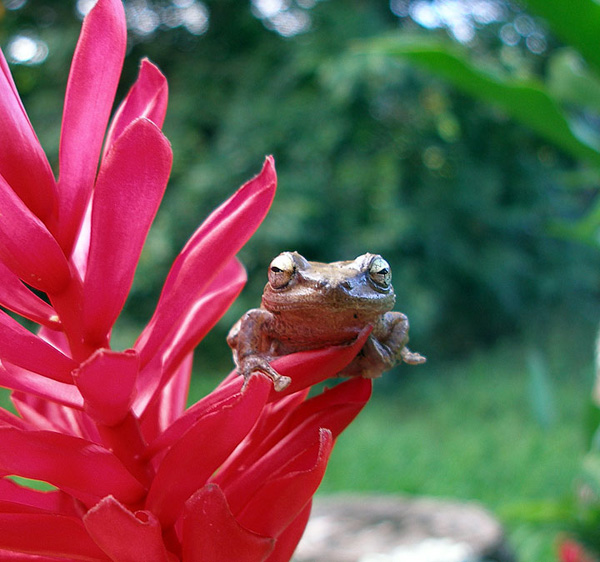
However, in today’s Hawaii, only native species are valued. Introduced species are now regarded as illegal aliens, and harboring these aliens is against the law. Laws defining the coqui as a “pest” allow the cruel slaughter of these tiny, harmless creatures, bypassing humane treatment laws.
The Good Shepherd Foundation, of which I am the director, believes that cruelty to animals is unacceptable, regardless of whether the animals are native or not. In 2001 we started a program to counter the anti-coqui propaganda, called CHIRP, or the Coqui Hawaiian Integration and Reeducation Project. Acceptance, we believe, is better than an endless environmental war against the frogs.
Over the years we have been contacted by many residents who found the frogs desirable on their property, but who were being harassed by neighbors who did not yet have the frogs and wanted them eradicated. This meant having one’s property sprayed with citric acid, which kills plants as well as coquis, lizards, insects, and other non-target species. The acid burns the victims to death.
Anti-coqui hysteria has made people fearful of admitting they like the coquis, faced with the unfortunate choices of harassment, or letting eradicators poison their property.
Some residents would like to remove the coquis to avoid the drama, but don’t want to kill the coquis in the process. These humane-minded people are faced with another dilemma. Moving coquis is a crime. The government has made it so people can only kill coquis, either with citric acid or by cooking or freezing the live frogs. You can’t legally catch the frogs and release them somewhere else where there are other frogs.
This means the Hawaiian government has made it illegal to treat the coquis humanely. It forces residents to either be cruel to the frogs, or to break the law and illegally release the frogs elsewhere, which many people do.
The most recent phone call was from a woman who wanted to save the lone coqui on her property from a certain death. A neighbor heard the frog and reported it to the homeowner’s association, which was dispatching an eradicator right away. The neighbor also complained that this same woman was feeding non-native birds, and threatened to have the birds shot.
For those who love wildlife, Hawaii is no longer a paradise. Species are not valued for their beauty and other positive qualities, or for the biological diversity they bring to these volcanic islands. Instead, they are valued solely for being “native,” and are killed solely for being introduced.
It is a war on wildlife. Property owners, residents, and visitors who value wildlife for what it is, regardless of whether or not it was introduced, are victims of this war.
For more, see our website, www.HawaiianCoqui.org.
Guest post: Sydney Ross Singer is a medical anthropologist, author, and director of the Good Shepherd Foundation. He lives on a coqui frog sanctuary with his wife and son on the Big island of Hawaii.
By: frogs are green,
on 8/28/2014
Blog:
Frogs Are Green
(
Login to Add to MyJacketFlap)
JacketFlap tags:
Book Illustration,
Environmental Books,
costa rica,
Children's Book Illustrator,
Learn about Frogs,
How You Can Help,
Children and Nature,
frog exhibits,
Frog Conservation,
People Helping Frogs and Toads,
Frog People,
Literary Amphibians,
frog gifts,
Frog fun,
Teaching Kids about Frogs,
Manchester Museum,
A-Z Frogs,
Eco Interviews,
Children's Books on Frogs,
Frogs and Artists,
Frogs and Insects,
Lizards & Iguanas,
animal and amphibian illustrator,
Artist UK,
Boy who really really really loves lizards,
Illustrator and Conservationist,
John Hamilton,
Monkey Frog,
Vivarium Manchester Museum,
Add a tag

When did this all begin? Please tell us a bit about your work.
I am an artist and illustrator based in Manchester UK. My artwork has always been narrative /story-based, using oil on canvas, printmaking, and large-scale collage. My work includes characters acting out various scenarios and role play, as if from a film or stage play. I often include animals or people dressed as animals. I recently had a children’s picture book published called “The Boy Who Really Really Really loves Lizards” aimed at 3-7 year olds.
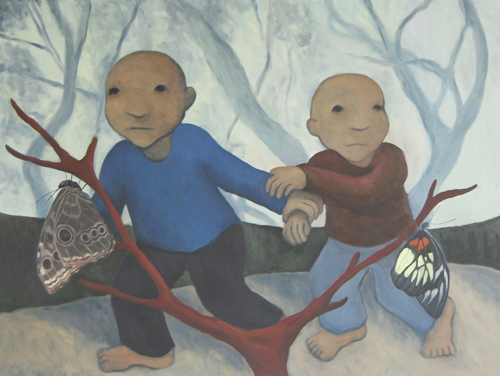
What is your educational background and what lead to this creative path?
My background is in Fine Art. I did my degree back in 1990 and have been a practicing artist since then. A couple of years ago I did a Masters degree in Children’s Book Illustration. For the final project I wrote the story about my son Oliver who was obsessed by visits to the Manchester Museum, From the age of two he has loved the museum and would spend hours there.
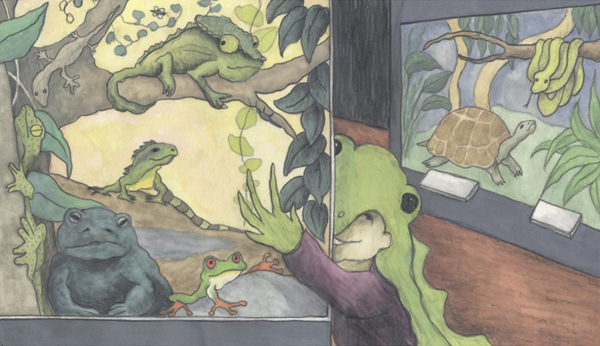
What are some challenges you have faced and how did you deal with them?
When I was doing research at the museum for the book, I became friendly with Andrew Gray, the curator of the vivarium. He specializes in the conservation of frogs and has done a lot of work to project many endangered species from Costa Rica and other places. His passion and commitment to the Museum is amazing. He was also responsible for getting the museum to publish my book which is a playful look at my boys obsession with the museum and the lizards, frogs and snakes. I think we saw it as a way to engage the younger visitors and to perhaps encourage them to become aware of the conservation involved. The museum features heavily in the book.
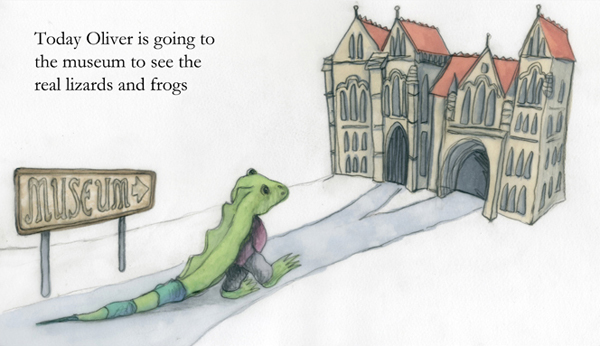
What can people do to help this cause?
The museum allows the public to sponsor the frogs and to contribute to the cost of research and support for the museum. Oliver recently sponsored a tiger monkey frog and got to meet it and hold it at the museum! You can also buy my book too!
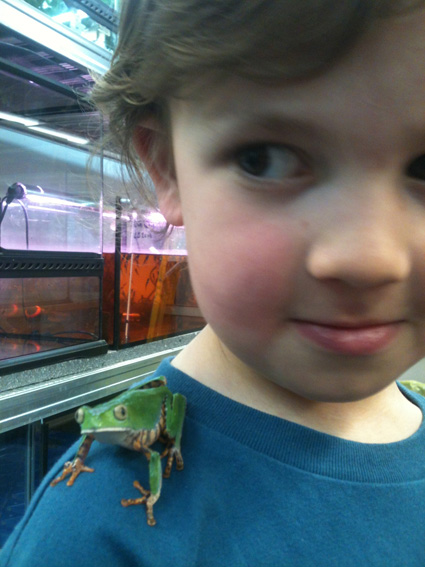
How do you reach your targeted audience?
Is it through your website, advertising or social media or another route? Which is most effective and why?
I am trying to promote my book at the moment and I have been doing that through Facebook and Twitter as they both allow you to reach a large volume of people very quickly. It is also a good way of keeping in touch with people and informing them of events and new work. There is also a website for the book where I post features, reviews and workshop projects done with schools and colleges.
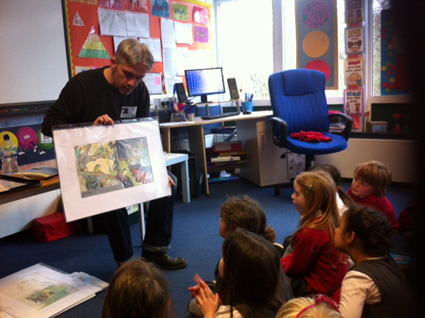
How do you keep the audience engaged over time?
Updates on Facebook and Twitter and by creating new links with organizations and groups with similar interests.
Tell us about your events around the world and some of the campaigns you have started.
The book is only available in the UK so that has been my main target but I would love it to go further afield! I have had emails from people in South Africa, Australia, France and the USA who have received the book, many as presents from the UK – so that is exciting!
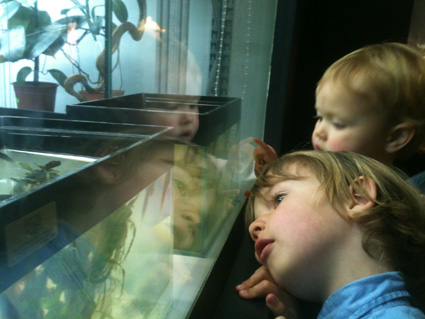
What is in the works for the future? What haven’t you yet tackled, but will want to do soon?
I am working on another picture book possibly about butterflies or snails! I am hoping the museum may show an interest in publishing this one too. I want to try and make this one a bit more factual and to include facts and information to allow children to continue their interest in the subject.
Would you like to add a bit more?
No. Just a thank you for the opportunity to talk about the book and hopefully reach a few more people and encourage some more young people to really, really, really love lizards and frogs!
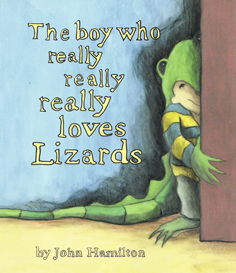
To find John Hamilton online:
Website: http://www.johnhamiltonillustration.com
Facebook: https://www.facebook.com/tbwrrrll
Twitter: @JohnHamilton17
For information on the Manchester Museum and their work with frogs and about sponsoring the frogs visit:
http://frogblogmanchester.com
By: frogs are green,
on 8/22/2014
Blog:
Frogs Are Green
(
Login to Add to MyJacketFlap)
JacketFlap tags:
Recycle,
recycling,
Children and Nature,
Environmental Health,
Chemicals in the Environment,
City of Jersey City,
sustainable products,
Sustainable Choices,
Sustainable JC,
HCIA,
Hudson County,
learning to recycle,
riverview neighborhood association,
Zero-Waste,
Add a tag
 Yesterday I had an argument with someone I know. She was mixing all the trash into one bag to put out on the street. No matter what I said, she refused to separate the trash. Why is it so hard for some people to follow the rules (the law)… not just because the city tells us to, but because it’s right for our community and our planet.
Yesterday I had an argument with someone I know. She was mixing all the trash into one bag to put out on the street. No matter what I said, she refused to separate the trash. Why is it so hard for some people to follow the rules (the law)… not just because the city tells us to, but because it’s right for our community and our planet.
My community has a trash problem, city wide actually. The street cleaners (physical people) are currently at a minimum. I see someone maybe once a week and that’s not enough to pick up after citizens who believe there is someone walking directly behind them ready and waiting for their chip bag, pizza plate or empty soda can. What kind of parent doesn’t teach their children to respect others, our community, and has those same bad habits? Store owners don’t bother to come outside and pick up the trash right outside their door.
And… we’ve got another problem (worse than regular trash, if you know what I mean) with the homeless who are living on the streets.
Lately, the Riverview Neighborhood Association has pushed back against this with their own “clean-up” project, one street at a time. Very impressive initiative, which more neighborhood associations need to implement.
The City of Jersey City and Sustainable JC have hosted conferences in City Hall such as the Zero-Waste Conference, but of course the people who attend (like me) already care about this issue, so how can we reach the people we need to?
Anyway, in case you’re not sure what the “Trash/Recycling” law is, here in Hudson County, here are some details via the Hudson County Improvement Authority — http://hcia.org Visit their website, because there is a lot more information including what you cannot recycle!
Solid Waste Management
Each and every day, Hudson County residents generate more than 1,500 tons of solid waste! Much of this can be harmful to our environment if disposed of improperly. Making certain that this trash is disposed of in an environmentally sound and cost-effective manner is the highest priority for the HCIA and its Division of Solid Waste.
Recycling
In Hudson County, recycling has become an important method of waste management. Materials that were once thought to be unrecyclable are now being commonly recycled. However, there are still some materials that can not be recycled and those that can be need to be prepared correctly for recycling so that they can be reprocessed into new products.
Paper
Paper and paper products comprise approximately 32% of the waste stream in Hudson County. There are many different types of paper:
* Corrugated Cardboard
* Chipboard & Paperboard
* Mixed Paper
* Phone Books
* Hi-Grade Office & Computer Paper
Plastics
Plastics can be very mysterious because each type is made up of different chemical components. Therefore, it is essential that only similar types get recycled together.
For Better Recycling
Sorting different types of plastic is essential to producing high quality recycled products. Check with your local recycling coordinator as to which types of plastics are collected by your municipality.
Glass
Recycle only glass bottles and jars from food, beverages and medicine. Do not recycle light bulbs, glassware, ceramics and window glass, which are each made of different ingredients, and by different processes.
Aluminum, Tin and Steel Cans
Typically, the only kind of aluminum your town wants set out for curbside collection is aluminum beverage cans. You can test if a can is aluminum or steel by using a magnet: a magnet won’t stick to aluminum. Unless indicated differently, glass, aluminum, steel and tin cans can be commingled for collection.
By: frogs are green,
on 8/19/2014
Blog:
Frogs Are Green
(
Login to Add to MyJacketFlap)
JacketFlap tags:
Learn about Frogs,
People Helping Frogs and Toads,
Frog People,
Frogs in Film,
Eco Interviews,
Frogs and Artists,
Brazil frog mural,
Brooklyn snail mural,
EverFresh Studios,
frog murals,
jersey city frog mural,
makatron,
Melbourne frog mural,
Mike Maka,
mike makatron art,
mural artist,
Sao Paulo frog mural,
street mural art,
Add a tag
When was your organization founded?
I’ve been a full-time artist since 2007, but making art since kindergarten, like when everyone else started.
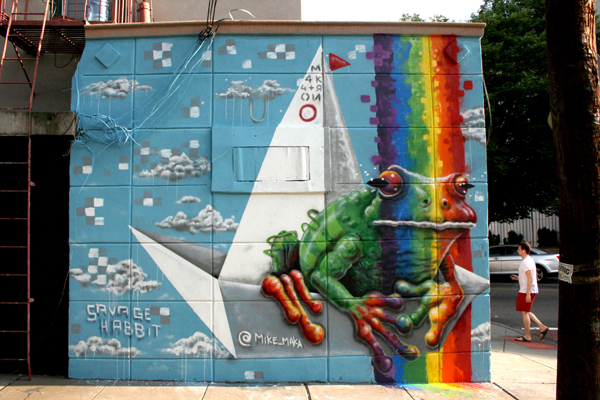
What is your educational background and what lead to creating this organization?
(I’m not really an organization, nor am I especially organized.)
I studied in universities in New York, Adelaide, and Melbourne, but have learned a lot from friends and travel. Studies included illustration, fine art, graphic design, philosophy of art, etc. But working many years as a bike courier and enjoying the extreme side of life naturally led to climbing buildings, street art and graffiti. which has turned into a career or life.
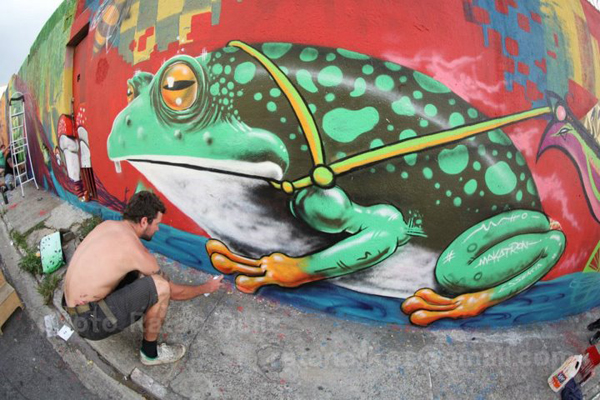
What are some challenges you have faced and how did you deal with them?
I struggle with the business side of being an artist, such as pricing things, understanding the bigger market picture of what I offer, and finding a balance of creative projects with necessary business operations. I’m trying to get other people to do certain things, like social media, proposal writing, residency research and grants, and graphic design. Things that I am good with, but will let me create more art. I have learned over the years that the choices I make to do projects that are more fun, and the content or imagery that I find to be the most fun and challenging, without worrying about a client or people’s opinion in general, will lead to further projects in the same vain… and the money side of things takes care of itself. (Example: people will approach me to do paid projects for what I want to do, rather than when I started… I would compromise to suit a certain type of cafe for example.)
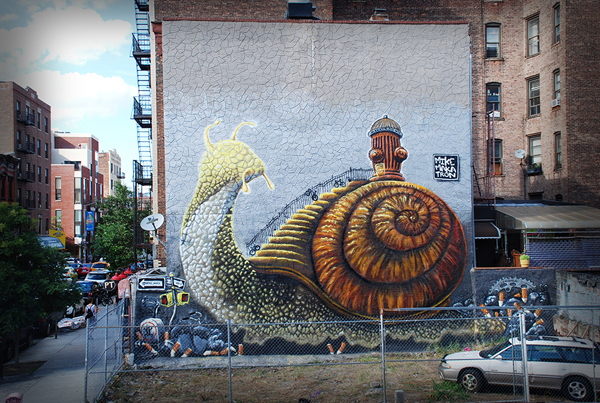
How do you reach your targeted audience?
Is it through your website, advertising or social media or another route? Which is most effective and why?
I paint a lot on the streets, which is a better feeling of ephemerality than canvas work. More people will see street works than in a gallery, but many more will see the art on the internet.
I don’t like to think in terms of advertising, or branding, as it kills the creativity.
There are a lot of bloggers out there who put my stuff on social media, but Instagram seems to be the main thing at the moment, and the best thing for me is it keeps me off Facebook with the direct share option.
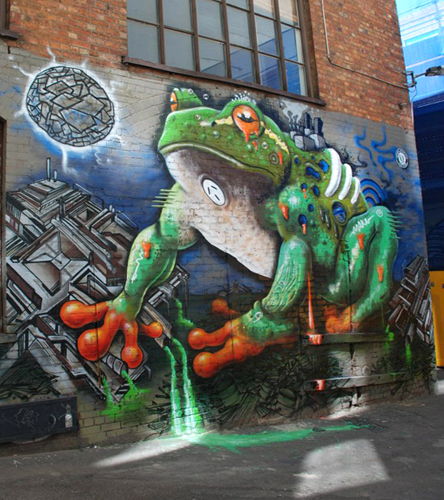
How do you keep the audience engaged over time?
I think I have more of a problem of changing styles and content too much that would loose an audience, but again I don’t like to think about engaging an audience, but aim at an introspective view of my own mind. It does make me happy to know people enjoy some of my work, but also makes me happy when I can create something that isn’t main stream and doesn’t have mass appeal .
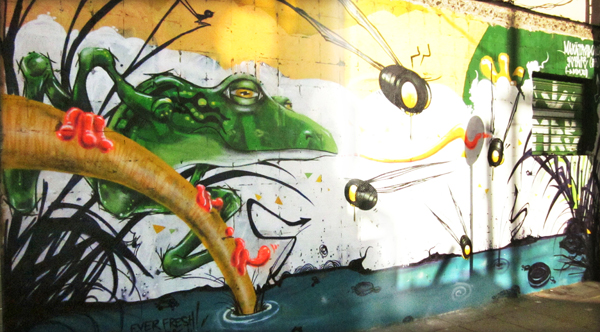
Tell us about your events around the world and some of the campaigns you have started.
I recently spent a month in New York City, painted many walls and went up to Toronto and through Los Angeles to paint a few walls. I’ve painted in around 20 countries and hope to paint more.
What is in the works for the future? What haven’t you yet tackled, but will want to do soon?
I have a lot of walls to do in Melbourne in the next month. September 6th will be the opening day of the new Everfresh Studios. October, I am planning a month long freedom drive up the east coast to link up 4 paid projects as well as whatever else I can find along the way. Living and working out of my bus (and probably a few friends houses.)
Later in November, I’m going to be the subject of a German documentary film crew, who will shoot an episode for their series.
I also plan on being back at the Miami Basel in December, and have plans to build a pyramid in Tulum or Playa del Carmen, which will be an art piece, but also a functioning permaculture garden prototype.
I am looking at art residencies in some Latin countries, and hope to be able to make this happen in 2014. Hopefully, Portugal, Brazil or somewhere Spanish speaking.
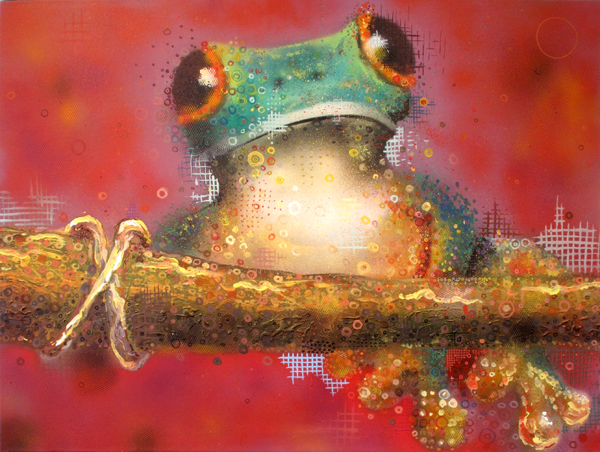
Bonus Bite:
The big snail wall has a frog reference, on the post box bottom right in the rubbish, the Puerto Rican guy who owned the building asked me to do his tattoo, a native symbol of his homeland, which is a famous frog, I can’t remember the name, but it was taken to Hawaii for some reason to do with people working there. I think they missed the sound it made, but they didn’t take the natural predator, so it thrives in Hawaii now… (this is the Coquí, Eleutherodactylus coqui)
To learn more about Mike Maka, visit the links below:
Website: http://www.makatron.com
Instagram: Instagram.com/mike_maka
Facebook: Mike Makatron
Vimeo: https://vimeo.com/mikemaka
By: frogs are green,
on 8/10/2014
Blog:
Frogs Are Green
(
Login to Add to MyJacketFlap)
JacketFlap tags:
Insects,
Lizard,
mosquitoes,
Living a Frog-Friendly Life,
Teaching Kids about Frogs,
Providenciales,
wildlife conservation,
Frogs and Insects,
Lizards & Iguanas,
Bark Anole,
Green Anolis Distichus,
lizard eats insects,
Lizard in caribbean,
Turks & Caicos,
Add a tag
The island of Providenciales in Turks & Caicos is one of my favorite vacation spots and I have been there many times. The sand is pinkish white and as soft as talcum powder. The sea is the perfect color of turquoise and crystal clear. When you enter the water all you see are little fish and if lucky, while swimming, the local dolphin that comes over to greet visitors.
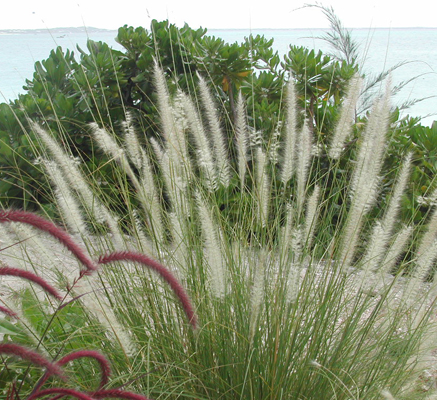
Turks & Caicos beach plants and sea beyond. Photo by Susan Newman
On one of my trips as I was unpacking my things, I noticed a little lizard in my room and just left him to wander around. At the time, I didn’t know that much about them, but he/she was so cute, I didn’t bother it. Over the next few days, my friends were complaining about the mosquitoes and kept asking me, how come you aren’t bitten up like we are? I didn’t really know.
This went on for days until I told them about the little lizard in my room. OH! They said, it’s eating the mosquitoes in your room, that’s why you aren’t having the problem we are.
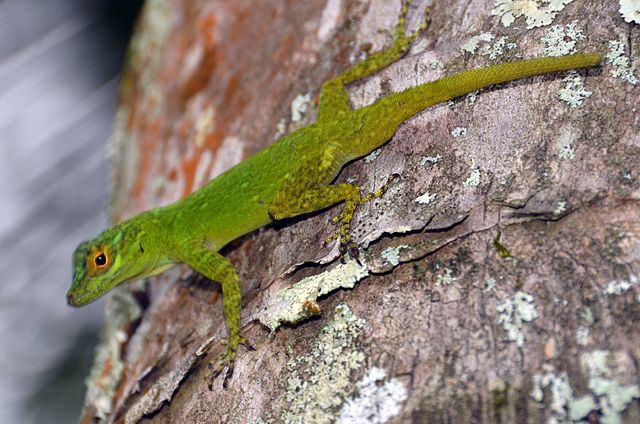
Green Anolis Distichus – photo taken by David Amsler, Wikipedia Commons.
Well, it is many years later and I know more about lizards, iguanas, salamanders and frogs. I wanted to share this little story because most people wonder how the decline of frogs and amphibians directly effects them. As you can see, just one lizard in my room on vacation, made all the difference for me having a more comfortable trip than my friends. Just imagine how insects will bother us if there are no frogs or lizards around to eat them?
By: frogs are green,
on 8/10/2014
Blog:
Frogs Are Green
(
Login to Add to MyJacketFlap)
JacketFlap tags:
Insects,
mosquitoes,
Living a Frog-Friendly Life,
Teaching Kids about Frogs,
Providenciales,
wildlife conservation,
Frogs and Insects,
Lizards & Iguanas,
Turks & Caicos,
gecko eating insects,
gecko in turks & caicos,
house gecko,
Add a tag
The island of Providenciales in Turks & Caicos is one of my favorite vacation spots and I have been there many times. The sand is pinkish white and as soft as talcum powder. The sea is the perfect color of turquoise and crystal clear. When you enter the water all you see are little fish and if lucky, while swimming, the local dolphin that comes over to greet visitors.

Turks & Caicos beach plants and sea beyond. Photo by Susan Newman
On one of my trips as I was unpacking my things, I noticed a little gecko in my room and just left him to wander around. At the time, I didn’t know that much about them, but he/she was so cute, I didn’t bother it. Over the next few days, my friends were complaining about the mosquitoes and kept asking me, how come you aren’t bitten up like we are? I didn’t really know.
This went on for days until I told them about the little gecko in my room, who like to come inside where the temperature is to their liking and are safe from predators. OH! They said, it’s eating the mosquitoes in your room, that’s why you aren’t having the problem we are.
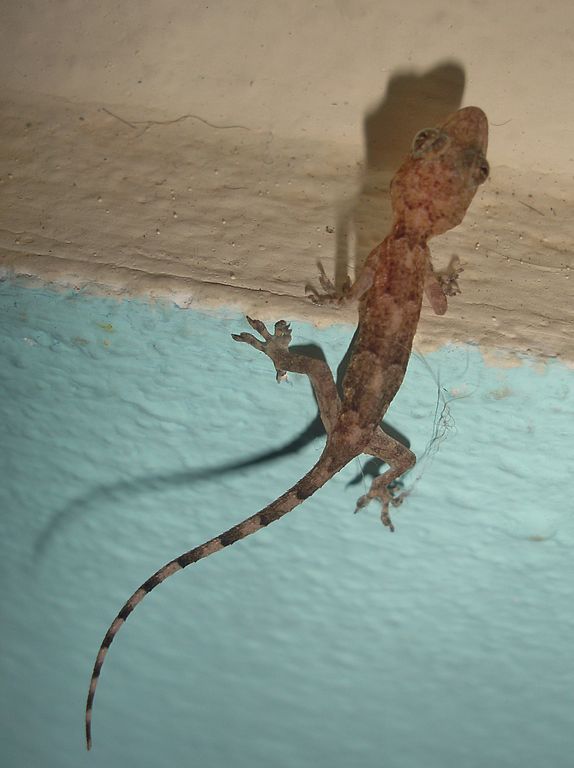
Tropical House Gecko (Hemidactylus mabouia) by Thomas Brown
Well, it is many years later and I know more about geckos, salamanders and frogs. I wanted to share this little story because most people wonder how the decline of frogs and amphibians directly effects them. As you can see, just one gecko in my room on vacation, made all the difference for me having a more comfortable trip than my friends. Just imagine how insects will bother us if there are no frogs or geckos around to eat them?
By: frogs are green,
on 8/10/2014
Blog:
Frogs Are Green
(
Login to Add to MyJacketFlap)
JacketFlap tags:
Children and Nature,
People Helping Frogs and Toads,
Frog People,
Amphibian habitat loss,
Creating a Wildlife Friendly Backyard,
frog-friendly garden,
Teaching Kids about Frogs,
frog ponds,
attracting frogs naturally,
compost heap,
garden pond,
garden pond plants,
garden ponds,
Add a tag
For most people making your garden a friendly area for frogs seems like a strange idea, but what we often don’t have is understanding. These often misunderstood amphibians are one of the nicest critters you can attract to your garden. In many ways frogs can be amazing survivors, however changing habitats over the years have caused them great distress and they are disappearing at an alarming rate [1]. You should keep in mind that introducing non-native frogs to the local ecosystem is a pretty bad idea, sometimes even forbidden by laws and for a good reason [2]. You can, however do your best to attract the local frogs to your garden, as they will be quite useful and great companions.

Frog pond by Eagle lake in Acadia National Park, Mount Desert Island, Maine. Photo by JR Libby.
- You would do well to avoid simply introducing the frogs into your Bayswater garden, instead you should do your best to invite them by creating the right conditions for that.
- If you happen to have kids living with you, then they can learn to interact with the frogs. There is nothing to fear from most common variety frogs, so they can even be caught and picked up, just remember to treat them with respect and care.
- You can make a useful garden pond to allow amphibians to live there, but that means your pond will need to have shallow edges that taper off into surrounding moist vegetation, such as nice and leafy mulch. Frogs will need shelter from summer heat, though they tend to enjoy moving around most after moist and rainy weather. Overhanging trees are welcome, as long as they don’t completely cover the pond in shade, as the frogs will still need sunlight. You need to use a good mix of native pond plants, such as marsh marigolds, water violets and the like if you want to have good vegetation around and in your pond. Check a garden center for more information and the type of plants in your area you can use. Your pond should be about 2-3 feet in depth for optimal conditions.
- Another thing worth mentioning is that frogs will keep most insects away from your garden, since they dine on moths, mosquitoes, slugs, snails, flies, cockroaches, beetles and more. If you have a good combination of plants and shrubs native to the area as well as mulching your garden beds and keeping a good compost heap, then you will have a garden much more welcoming for amphibian guests.
- Having a good garden pond will also improve the conditions where they can breed in peace, but it mostly depends on how much peace they get while living there. Shade and good plant life will create exactly what they need for living there.
- There are some things to watch out for, which can be hazardous to frogs. If you do have frogs in your garden, you should pay special attention at all times when you’re using a string trimmer or mowing, or else you may hurt or even kill them. You must use a nylon mesh to keep your garden plants protected and that its size is good enough, such as at least 2 inches, as this will keep them away.
Sources:
1. Why are Frogs Disappearing?
2. Why Are Coqui Frogs a Problem in Hawai’i?
 Guest post by Ella Andrews, who is a writer and blogger with great flair for gardening and landscaping. She is focused on writing the best possible way and is always searching for new inspiration sources. Her present article offers non traditional methods for garden care.
Guest post by Ella Andrews, who is a writer and blogger with great flair for gardening and landscaping. She is focused on writing the best possible way and is always searching for new inspiration sources. Her present article offers non traditional methods for garden care.
By: frogs are green,
on 8/5/2014
Blog:
Frogs Are Green
(
Login to Add to MyJacketFlap)
JacketFlap tags:
Contests,
Children and Nature,
People Helping Frogs and Toads,
Frog People,
Iguanas,
wildlife conservation,
Baby Iguana,
caring for iguana,
Cleveland zoo,
Herps Alive,
Keith Gisser,
live animal prizes,
Ohio State Fair,
teaching children about iguanas,
winning pets state fair,
Add a tag
We’ve all been to our local county fair, rode on the ferris wheel, sprayed the water in the clown’s mouth, maybe even won a big stuffed frog. But what’s happening in Ohio (and perhaps other places) is the wrong way to get young people interested in caring for wildlife. Naturally, as people walk by a booth and see what seems like an easy game to win and the prize is a real, live, baby iguana, they are so tempted. Yes, they’ll win a baby iguana! This is so very wrong and has to be banned, now!
Here’s the story by Keith Gisser, founder of Herps Alive!

The Ohio State Fair in Columbus featured a booth that offered live iguanas as prizes.
It started as one of those non-funny jokes. A friend posted this photo on Facebook last Tuesday and tagged me, asking, “How soon until you start getting calls on these, Keith ?” The answer turned out to be Sunday. That didn’t take long at all, did it.
An Ohio State Fair booth was offering baby iguanas as prizes. The needed skill? Not knowing how to care for a live animal. Let alone a tough-to-care-for properly green iguana (Iguana iguana). But knowing how to toss a Ping Pong ball into a fishbowl.
These days most places don’t even give away love goldfish. They give a coupon for the goldfish. That makes sense. Win. Think about if you really want the animal. Go to pet store. Buy proper equipment. Then flush him two weeks later (the expected life span of a goldfish is two weeks. I am quite sure of this).
But not so with iguanas. A young man won his and brought it back to Cleveland (a two-hour plus drive plus who knows how long carrying him around in a box while enjoying healthy far food like chocolate dipped bacon. And a ride on the Tilt-A-Whirl. He was there with friends and mom and dad were a bit surprised. But they did the right thing. They went to the pet store, started reading the care sheet and realized this was way beyond what they were prepared for. They called around and eventually the Cleveland Zoo referred them to the Herps Alive Foundation. I was doing an outreach event at a Petco store and arranged to pick him up.
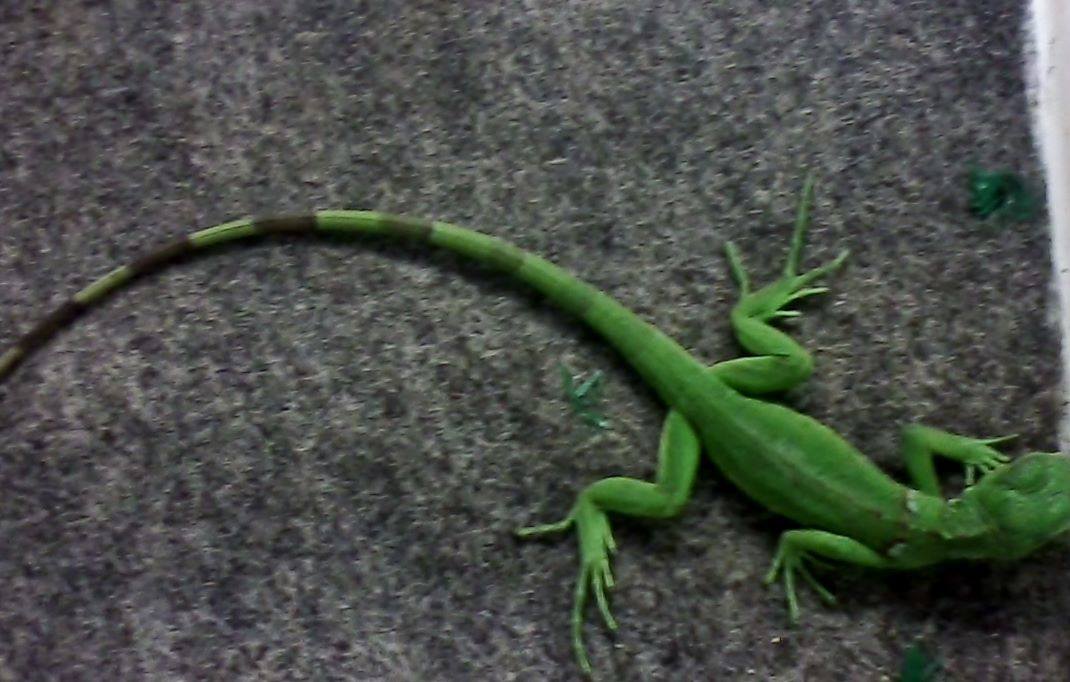
The iguana in question.
Fortunately this little hatchling is pretty healthy and eating. With full spectrum light and heat he should live a long and happy life. We hope to find a permanent home for him soon.
You might be surprised that after my bad experience with reptile laws in Ohio, that I really think we need a law banning these guys (and all live animals) as prizes. Many states and localities ban this practice, but not our state. Time for a change. Or a change.org perhaps. Give ‘em a coupon. Or a stuffed iguana.
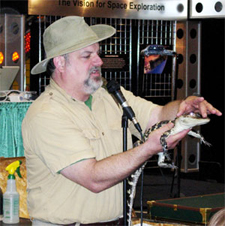 Keith Gisser runs the Ohio based, award-winning, nationally recognized interactive reptile and amphibian program Herps Alive! He has been a herpetology educator for over thirty years and currently maintains about 100 reptiles, amphibians and crocodilians, nearly all adoptions or rescues, about half of which are used in his programs.
Keith Gisser runs the Ohio based, award-winning, nationally recognized interactive reptile and amphibian program Herps Alive! He has been a herpetology educator for over thirty years and currently maintains about 100 reptiles, amphibians and crocodilians, nearly all adoptions or rescues, about half of which are used in his programs.
By: frogs are green,
on 8/1/2014
Blog:
Frogs Are Green
(
Login to Add to MyJacketFlap)
JacketFlap tags:
Fungal infections in wildlife,
Bowdoin College,
Herpetological Review,
Nathaniel Wheelwright,
Ranavirus,
tadpoles maine,
University of Tennessee,
Learn about Frogs,
frogs and pesticides,
Environmental Health,
Chemicals in the Environment,
Frog People,
Climate change and frogs,
Metamorphosis,
chytrid fungus,
frogs as bioindicators,
Chytrid disease,
Creating a Wildlife Friendly Backyard,
Teaching Kids about Frogs,
Amphibian research,
Add a tag
An estimated 200,000 Wood Frog (Lithobates sylvaticus) Tadpoles in a local pond in Maine died within a few days (in 2013) from most-likely a ranavirus. A paper was recently published in Herpetological Review that is co-authored by Nathaniel Wheelwright, a biologist at Bowdoin College, along with the University of Tennessee.
“The dead tadpoles had signs of hemorrhaging in their legs and around their throats, and many had skin that was sloughing off their bodies”, Wheelwright said.
Wheelwright has monitored the pond for close to 30 years and said it was quite surprising. Usually there are 50-100,000 tadpoles and only 1000 may live to become adult frogs. But for all to die, very unusual. They did notice there were no leeches present.
There are other species who can carry the ranavirus, such as green frogs, bullfrogs, painted turtles and spotted salamanders* (*who were found in the pond and showed signs of suffering from the virus also.)
Here’s a video from Bowdoin College with biology professor, Nat Wheelwright talking about the tadpoles:
The good news is that this past Spring showed healthy tadpoles and frogs and no sign of any issues.
Do you think this was caused by pesticides and/or climate change? Too many tadpoles crowded together?
___________________________________________________________________
The differences between Chyrid Fungus and Ranavirus are:
Chyrid is a fungus and infects individual frogs who suffer damage to their skin. Once infected it impairs respiration and the frog dies. It has been devastating amphibian populations around the world.
Ranaviruses infect insects, fish, amphibians and turtles and infect larvae or recently metamorphosed individuals.
By: frogs are green,
on 7/21/2014
Blog:
Frogs Are Green
(
Login to Add to MyJacketFlap)
JacketFlap tags:
How You Can Help,
frog exhibits,
Frog Conservation,
People Helping Frogs and Toads,
Frog People,
Sherry Neidigh,
Frogs in Film,
Frog posters,
Teaching Kids about Frogs,
Frogs Are Green posters,
Paul Zwolak,
Sylvie Daigneault,
Kerry Kriger,
Photographing Frogs and Toads,
wildlife conservation,
Wes Deyton,
See.Me,
SeeMe in Times Square,
Susan Newman,
Add a tag
See.Me is taking over two billboards in Times Square to showcase artwork! These five Frogs Are Green posters will be displayed among the work of other artists! Congrats to all… So head to New York City at Broadway and 46th Street on Thursday, July 24 8-9 pm! Artists featured are Paul Zwolak, Kerry Kriger, Sherry Neidigh, Sylvie Daigneault and Wes Deyton and the Frogs Are Green founder and designer, Susan Newman. See.Me will be photographing the show, but I will make a point of heading into NYC and recording it myself, if I can catch the imagery at night. Here’s a link to see what it’s about: https://www.see.me/
Below are the five posters to be featured:
By: frogs are green,
on 7/9/2014
Blog:
Frogs Are Green
(
Login to Add to MyJacketFlap)
JacketFlap tags:
University of Maryland,
Everything Changes,
wildlife conservation,
Sustainable Choices,
urban farming and composting,
Frogs and Artists,
Allison Green,
Deeply Rooted,
insect/plant relationships,
Jersey City Fine Artist,
Lilly Wei,
lush forest,
mating snails,
New York Botanical Gardens,
painting foliage,
painting nature,
Pennsylvania forests,
plant's life cycle,
pristine terrain,
PULSE NY,
Studio Art Centers International,
Susan Eley Fine Art,
swarm of bees pollinating,
urban nature,
wild plant life,
Brooklyn Museum,
Children and Nature,
Environmental Health,
People Helping Frogs and Toads,
Living a Frog-Friendly Life,
High Line,
Entwined,
Creating a Wildlife Friendly Backyard,
life forms,
Climate change and the Environment,
lotus flower,
Add a tag
Frogs Are Green founder, Susan Newman interviews Allison Green about her large-scale, exquisite paintings of nature. Here’s what Allison shares with us:
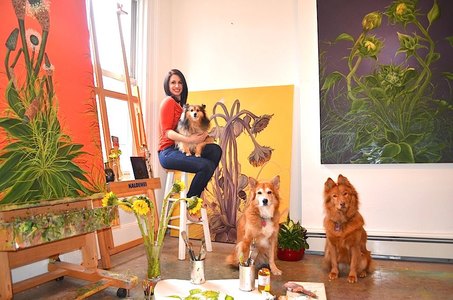
It’s hard to say exactly why I paint nature - but I am sure that it roots from my childhood life in Pennsylvania, where I grew up in a house on the perimeter of a lush forest. Memories of a childhood which revolved around nature are deep within me, especially today, as I have been living in the city for the last 20 years. Sometimes I wonder if I paint nature because I long for those lush forests of my childhood, or if it is the stories in those trees which still resonate so deep with in that I feel the need to let them out. Or, maybe it’s a combination of both.
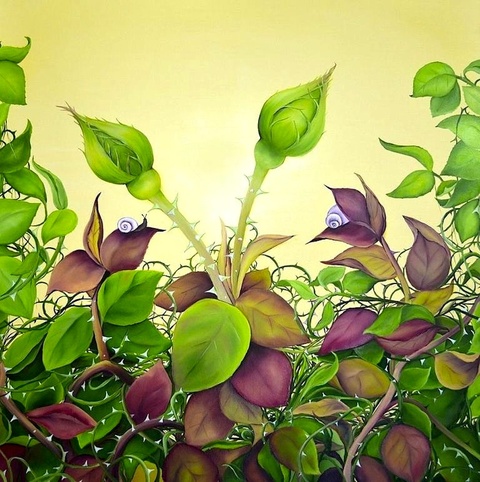
April Roses, 2013 – Oil on Canvas, 48″ x 48″
These days, while I still love exploring vast forest and other pristine terrain, I have become most inspired by urban nature – from cultivated gardens like the High Line and the New York Botanical Garden, to the wildest of plant life that seems to sprout everywhere throughout the city and streets.
My inspiration often comes from the smallest details of a plant, such as the complex anatomy of a tiny, overlooked weed, the gnarled bark on an old, giant tree in the park, or those resilient vines growing up the sides of buildings in the summertime.
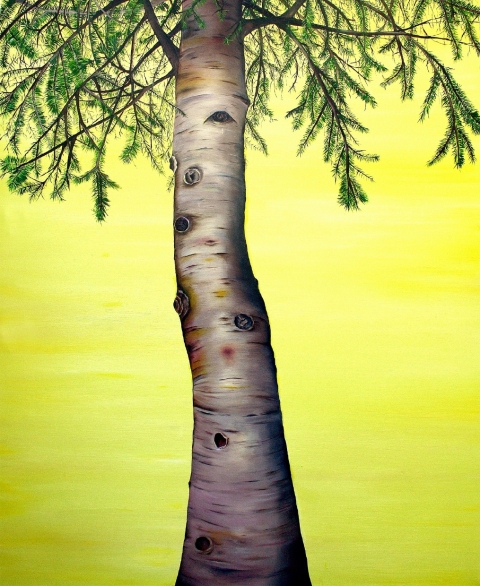
Eve, 2010 – Oil on Canvas, 30″ x 24″
In my most recent paintings, I’ve also become fascinated with the delicate and complex reproductive relationships between plants and insects. A swarm of bees pollinating a pair of desirable lotus flowers, while mating snails hide within an ever-evolving rose bush are examples of new imagery in which I seek to capture the magical and surreal natural world.
In addition, I’ve become fascinated by the way all life forms change, evolve and become something very different along the way. “Everything Changes”, my latest series, documents different phases in a plant’s life cycle, along with depicting insect/plant relationships.
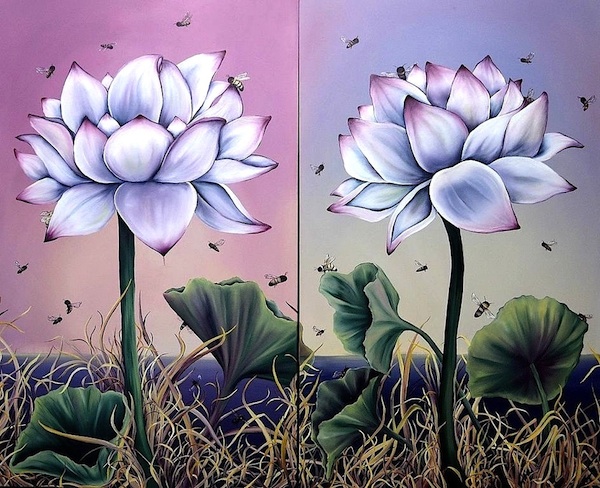
Pollinate Me (lotus flowers with pollinating bees) 2014, Oil on Canvas, 60″x72″
Nature is such an amazing, endless source of inspiration. And as humans are putting it in jeopardy in so many different ways, it has become an even more important subject in my mind. Whether it be to find beauty in a simple weed, cherish a neighborhood tree, or to realize the perfection of most common little bug, I hope that my work can inspire someone to look at plant life and all of nature in a new way every day.
— Allison Green, Jersey City Artist

Lovers, 2010 – Oil on Canvas, 60″ x 48″
Currently Allison resides and works in downtown Jersey City, where she creates large-scale oil paintings. Her first solo exhibition, “Deeply Rooted”, opened in March 2011 at Susan Eley Fine Art in New York City. A second solo show at SEFA, “Entwined”, opened in September 2012 and features a fully illustrated catalog with an essay by Lilly Wei. Green’s work is now included in the Brooklyn Museum Elizabeth Sackler Feminist Art Base, and her paintings were recently exhibited at PULSE NY in spring 2013.
Green holds a BA from the University of Maryland with a concentration in Fine Art and Women’s Studies. She also studied at Studio Art Centers International (SACI) in Florence, Italy in 1995.
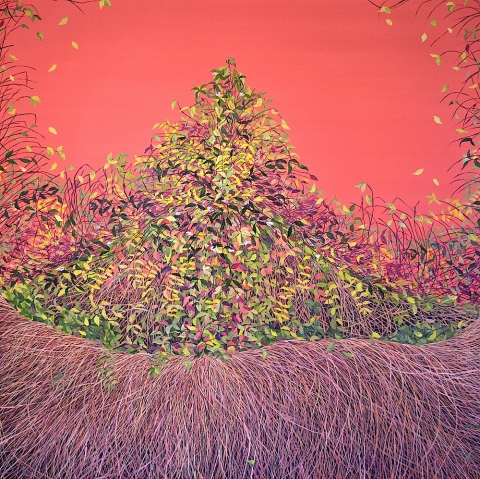
Sienna Thicket (Thicket #4) 2011, – Oil on Canvas, 48″ x 48″
By: frogs are green,
on 7/7/2014
Blog:
Frogs Are Green
(
Login to Add to MyJacketFlap)
JacketFlap tags:
ponds,
biodiversity,
How You Can Help,
Environmental Health,
People Helping Frogs and Toads,
Frog People,
Living a Frog-Friendly Life,
Creating a Wildlife Friendly Backyard,
cleaning ponds,
oxygenating marginal plants,
pond ecosystem,
pond maintenance,
pond pumps,
pond wildlife,
ponds and frogs,
Add a tag
Ponds are an incredible edition to any garden and are perfect for attracting a whole range or wildlife; from the fish you may have purchased to the frogs, toads and newts you hope might come and visit. Ponds are a delicate ecosystem; the perfect blend of fish, oxygenating marginal plants and natural wildlife is sometimes hard to get right, but one of the things that can definitely help is maintaining your pond properly.
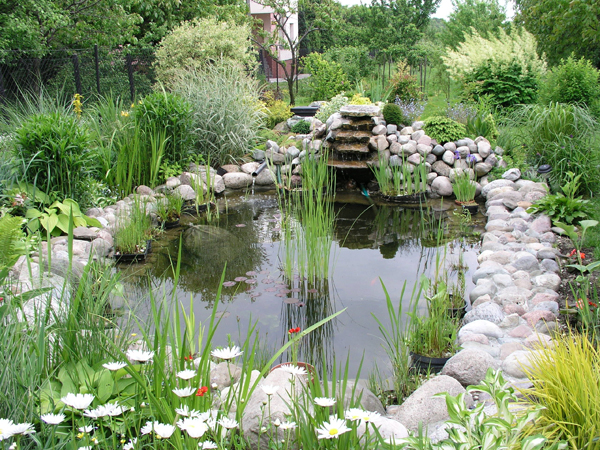
All ponds need regular maintenance to prevent them from turning into glorified bogs. Regular cleaning is a good idea to prevent silting up. Autumn is generally the best time for cleaning as much of the wildlife is less active or beginning to hibernate. Firstly, it is important to create a holding tank for your fish and other creatures and also your deep water plants using some of the pond water. Marginal plants should be alright as long as they are kept moist. The pond needs to be drained and the fish and creatures removed carefully and put into the tank as they become visible. Any decaying plant material may contain smaller creatures so place to the side of the pond so they can make their way back.
Remove any silt from the bottom of the pond. Most of this can be added to the garden to improve soil structure for your plants but do keep some in hand for replacing at the bottom of the pond. This is important for maintaining an ecosystem for smaller organisms which are beneficial for the pond.
The next step is to clean the liner with a brush and then refill the pond, preferably using rainwater collected from a water butt. Finally return the fish and other creatures and also the deep water plants to the pond.
After cleaning it can take a while for the pond to recover, which is the reason an autumn cleaning is generally preferred.
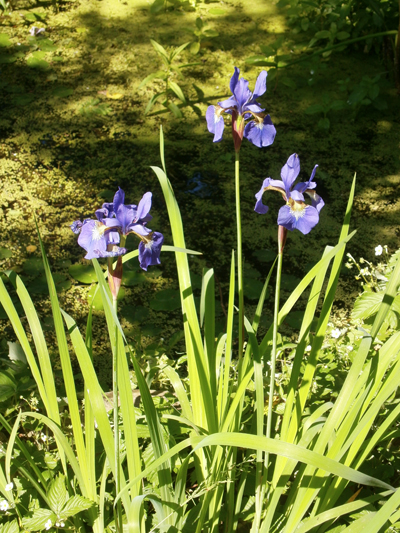
Another good practice to get into is maintaining your pond pump efficiently. If your pond does not have a pump they are readily available from retailers such as Swell UK in the UK. If you notice the pump is going slower or has stopped completely it might be that the pump is just clogged or suffering from a build-up of blanket weed. Alternatively there may be a problem with the electrics and cabling. The first thing to check is the electricity. Ideally you should have a circuit breaker and a switchbox. The circuit breaker will trip if there is a problem with the electrics; and the switchbox will isolate the different cables on the off chance you have accidently cut through a wire. If you have both of these you can diagnose the problem at the pump.
This problem is relatively easy to remedy; you can usually remove things easily enough from a pump. Pumps are relatively easy to take apart and put together again. If the pump looks green, then you have a problem with blanket weed, otherwise you need to look for the impeller (which is where the water from the pond is sucked in). This is where the blockages will be – use a screwdriver to clear out the cavity. Pond pumps need regular maintenance if you do not look after your pond properly.
And there you have it; a happy clean pond and a suitable working pond pump make for the perfect habitat for fish, frogs and other wildlife.

- Guest post by Chris Plum, pond and garden products advisor
By: frogs are green,
on 7/4/2014
Blog:
Frogs Are Green
(
Login to Add to MyJacketFlap)
JacketFlap tags:
Laurence Anholt,
Learn about Frogs,
Environmental Health,
Frog People,
Read about Frogs,
MOMA,
Creating a Wildlife Friendly Backyard,
Claude Monet,
Teaching Kids about Frogs,
Giverny,
Children's Books on Frogs,
Frogs and Artists,
France and Frogs,
frogs in art,
Geraldine Eischner,
Impressionist Claude Monet,
impressionist garden paintings,
Lisa Canney Chesaux,
Lisa Jobe Carmack,
Magical Garden of Claude Monet,
Metropolitan Museum of Art NY,
Museum of Modern Art NYC,
NYC Arts,
Philippe in Monet's Garden,
Stephanie Girel,
Waterlilies,
Where is the frog?,
Add a tag
Ever since I can remember having an appreciation for art, I was a fan of Claude Monet. A few weeks ago was watching the PBS program NYC Arts and one of the reports was about Monet’s Waterlilies at MOMA. I can’t even begin to tell you how many times I’ve seen those magnificent paintings. But it wasn’t until that evening that I made the Frog Connection. All of a sudden I thought, with all those 100s of paintings created in Giverny Garden, did Monet ever paint a frog?
After the program was over, I went on the internet and searched “Did Monet ever paint a frog?” What came up mesmerized me. Pages and links to children’s books on this very topic. After reading and studying many pages it’s hard to know the truth, especially given that Monet was an impressionist painter and so a green dab of paint might be misconstrued as a frog.
I read three of the children’s books and I’d like to share them with you:
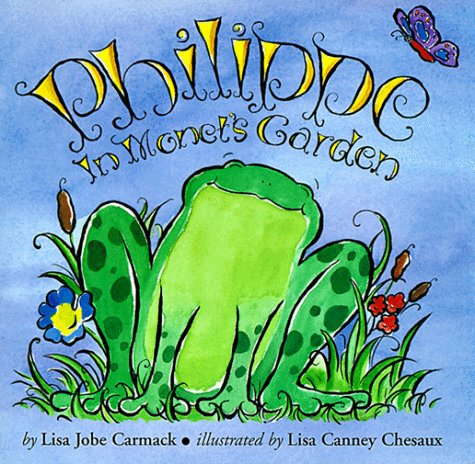
Philippe in Monet’s Garden
by Lisa Jobe Carmack and illustrated by Lisa Canney Chesaux
A charming story about a frog named Philippe, who just happens to live in France and just happens to have very large and long legs. As frog lovers, I’m sure you can imagine his potentially scary destiny to a local restaurant with all the frog hunters out there. Two of his frog friends get nabbed and so he hops away and away until he comes upon Giverny Garden where a sign is posted: No Frog Hunting! He’s safe! In he hops and Monet welcomes him, admires his large and beautiful legs and Philippe lives his life in that beautiful place with lots of bugs to eat and no fear. He may even be seen in one of the pictures?
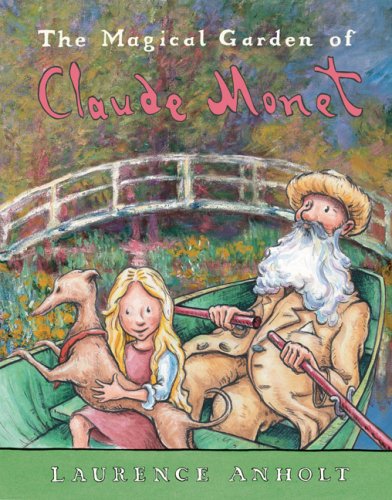
The Magical Garden of Claude Monet
by Laurence Anholt
This is more of an adventure story. A young girl and her pet dog are feeling antsy in their family’s urban dwelling, while the mother is busy painting a picture. But the mother reassures Julie that as soon as she’s finished, they will go on an exciting adventure to a magical place. They board the train to travel to Monet’s garden at Giverny and it’s an afternoon of marvel and discovery. Beautiful watercolor illustrations throughout the book. Unfortunately, no mention of frogs.
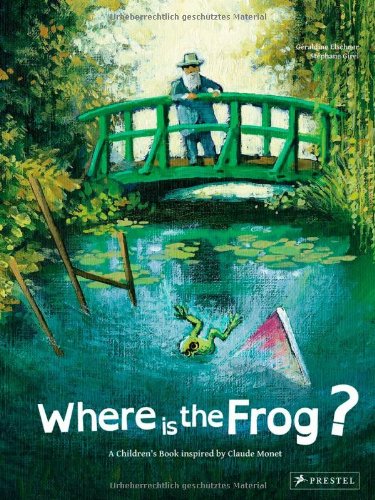
Where is the Frog?
by Geraldine Elschner and Stephanie Girel
A children’s book inspired by Claude Monet
As you might imagine, this one was my favorite! The illustrations throughout are styled after Monet and the story is adorable. In this story we have a little female frog named Antoinette who only wants to be the subject of Monet’s efforts. She moves and poses and when he walks away, she hops up to have a look at the painting and realizes that she was a green frog sitting on a green lily pad. Oh no, that’s why there is no frog in the picture. So the next day she poses hanging from a vine or within some flowers, and hooray, she’s depicted in the picture. She gets so excited she knocks the painting, easel, materials and herself into the water. Alas, still no picture with a frog in it!
— Susan Newman, founder Frogs Are Green

Water Lilies, 1919, by Claude Monet – Metropolitan Museum of Art, New York City
About Claude Monet’s Garden at Giverny (Wikipedia):
Claude Monet noticed the village of Giverny while looking out of a train window. He made up his mind to move there and rented a house and the area surrounding it. In 1890 he had enough money to buy the house and land outright and set out to create the magnificent gardens he wanted to paint. Some of his most famous paintings were of his garden in Giverny, famous for its rectangular Clos normand, with archways of climbing plants entwined around colored shrubs, and the water garden, formed by a tributary to the Epte, with the Japanese bridge, the pond with the water lily, the wisterias and the azaleas.
Monet lived in the house with its famous pink crushed brick façade from 1883 until his death in 1926. He and many members of his family are interred in the village cemetery.
Water Lilies (or Nymphéas) is a series of approximately 250 oil paintings by French Impressionist Claude Monet (1840–1926). The paintings depict Monet’s flower garden at Giverny and were the main focus of Monet’s artistic production during the last thirty years of his life. Many of the works were painted while Monet suffered from cataracts.[1]
By: frogs are green,
on 6/27/2014
Blog:
Frogs Are Green
(
Login to Add to MyJacketFlap)
JacketFlap tags:
TerraCycle,
Climate change and the Environment,
jersey city,
Mayor Steven Fulop,
sustainable products,
Sustainable Choices,
Off-site conservation programs,
urban farming and composting,
Bayshore Recycling,
Black Soldier Fly Larvae Composting,
Bureau of Recycling and Planning,
Dennis Whittinghill,
greener corners,
Hudson County Improvement Authority,
Judith Enck,
Keep America Beautiful,
PJ Wasinger,
Sustainable JC,
Urban Farm Expert,
Zero Waste Conference,
EPA,
Composting,
biodiversity,
How You Can Help,
alternative energy,
Environmental Health,
Chemicals in the Environment,
Add a tag
Did you know that each person produces 4.4 lbs of waste per day? Can Jersey City move towards “Zero Waste?
Yesterday, I attended the “Jersey City Moving Towards Zero Waste Conference” in City Hall and I have to say it was an eye-opening experience. The speakers and panel discussions were informative and I learned about what some of my fellow citizens are doing right here in Jersey City, as well as what is being done elsewhere.
Mayor Steven Fulop started off the conference by talking about how important this topic is and his commitment to doing what he can and I will say that the food and beverages provided for the event were accompanied by a composting bucket and two separate clearly marked waste barrels.
The Mayor introduced Judith Enck, the Regional Administrator of Region 2 of the U.S. EPA, and we learned about initiatives around the country and the world in comparison to what we aren’t yet doing here. I know that the trash is a problem across this city and something has to be done to change people’s behavior. It’s not enough for a few people to care, but we have to change the way people think about trashing their own neighborhoods, as if there’s someone behind them ready to pick it up. There isn’t.
Did you know that the Jersey City trash is picked up and shipped out of state by rail cars? What a waste of time, effort and fuel.
Here’s a current tv commercial playing about recycling from the “Keep America Beautiful” campaign:
Maybe we need a “Keep Jersey City Beautiful” or “Jersey City Proud” brand campaign?
The speakers were: Debra Italiano, Founder and Chair of SustainableJC; PJ Wasinger, Upcycle Jersey City Artist; April Buther Wennestrom, Director, Affiliate Services, Keep America Beautiful; Dennis Whittinghill, Urban Farm Expert, and DamagedWear; Albe Zakes, VP of Communications, TerraCycle; Eric Silverman, Principle, Silverman; Aaron Klein, CEO, Greener Corners; Dale J. Carpenter, Chief Sustainable Materials Management, EPA Section 2; Gary Sondermeyer, VP of Operations, Bayshore Recycling Corp.; Sondra Flite, Environmental Specialist III, Bureau of Recycling and Planning, Division of Solid and Hazardous Waste; and Norman M. Guerra, CEO, Hudson County Improvement Authority.
The big topics of the day were recycling (what and how), what some of these companies are doing to spread awareness and get people involved, and composting.
Until yesterday, I had never heard of “Black Soldier Flies.” It’s not the flies themselves that eat the waste, but the larvae. Pretty interesting!
From Wikipedia:
Black Soldier Fly Larvae Composting
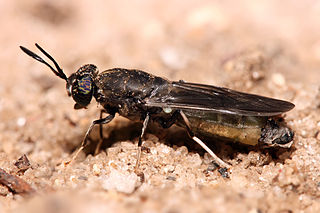 BSFL composting quickly converts manure or kitchen waste into an organic compost. In a compost bin, it can take only twenty days to start to compost. The resulting compost can be used for soil and fertilizers. After the conclusion of the compost process, the larvae can also be harvested as feed for poultry, chickens, and possibly dogs. On average a household will produce a little under a kg of food waste per day. This food waste can be composted at home using black soldier fly larvae much much faster than worms can do it. The BSFL will eat kilograms of scrap food a night in small composting units, eliminating your food waste before it can even begin to rot. This is probably the fastest composting technique. BSFL often appear naturally in worm bins, composting toilets, or compost bins. They can also be bought online. Without much added cost, these devices could be designed to also harvest BSFL.
BSFL composting quickly converts manure or kitchen waste into an organic compost. In a compost bin, it can take only twenty days to start to compost. The resulting compost can be used for soil and fertilizers. After the conclusion of the compost process, the larvae can also be harvested as feed for poultry, chickens, and possibly dogs. On average a household will produce a little under a kg of food waste per day. This food waste can be composted at home using black soldier fly larvae much much faster than worms can do it. The BSFL will eat kilograms of scrap food a night in small composting units, eliminating your food waste before it can even begin to rot. This is probably the fastest composting technique. BSFL often appear naturally in worm bins, composting toilets, or compost bins. They can also be bought online. Without much added cost, these devices could be designed to also harvest BSFL.
About Composting from Wikipedia:
Compost is organic matter that has been decomposed and recycled as a fertilizer and soil amendment. Compost is a key ingredient in organic farming. At the simplest level, the process of composting simply requires making a heap of wetted organic matter known as green waste (leaves, food waste) and waiting for the materials to break down into humus after a period of weeks or months. Modern, methodical composting is a multi-step, closely monitored process with measured inputs of water, air, and carbon- and nitrogen-rich materials. The decomposition process is aided by shredding the plant matter, adding water and ensuring proper aeration by regularly turning the mixture. Worms and fungi further break up the material. Aerobic bacteria and fungi manage the chemical process by converting the inputs into heat, carbon dioxide and ammonium. The ammonium is the form of nitrogen (NH4) used by plants. When available ammonium is not used by plants it is further converted by bacteria into nitrates (NO3) through the process of nitrification.
Compost can be rich in nutrients. It is used in gardens, landscaping, horticulture, and agriculture. The compost itself is beneficial for the land in many ways, including as a soil conditioner, a fertilizer, addition of vital humus or humic acids, and as a natural pesticide for soil. In ecosystems, compost is useful for erosion control, land and stream reclamation, wetland construction, and as landfill cover (see compost uses). Organic ingredients intended for composting can alternatively be used to generate biogas through anaerobic digestion. Anaerobic digestion is fast overtaking composting in some parts of the world (especially central Europe) as a primary means of downcycling waste organic matter.
— Susan Newman, founder, Frogs Are Green
Are you recycling and composting? Please share what you are doing to keep your neighborhood beautiful.
By: frogs are green,
on 6/18/2014
Blog:
Frogs Are Green
(
Login to Add to MyJacketFlap)
JacketFlap tags:
Learn about Frogs,
Meet the Frogs,
frog calls,
How You Can Help,
Frog Conservation,
Life Cycle of Frogs,
Frog People,
Living a Frog-Friendly Life,
Amphibian habitat loss,
Climate change and frogs,
Amphibian research,
A-Z Frogs,
CAMP,
People Helping Frogs and Toads,
wood frog,
United States Geological Survey,
Read about Frogs,
Pine Barrens treefrog,
American bullfrog,
Teaching Kids about Frogs,
green frog,
wildlife conservation,
Pickerel frog,
Spring Peeper,
NJ Frogs Toads Amphibians,
American Toad,
amphibian calls nj,
Calling Amphibian Monitoring Program,
Carpenter Frog,
Conserve Wildlife Foundation of NJ,
Cope's Gray Treefrog,
Eastern Spadefoot,
endangered amphibians NJ,
Endangered and Nongame Species Program,
ENSP,
Fowler's Toad,
frog calls new jersey,
gray treefrog,
Green Treefrog,
New Jersey Chorus Frog,
New Jersey Frogs,
Northern Cricket Frog,
Southern Leopard Frog,
threatened amphibians NJ,
unknown gray treefrog species,
Add a tag
The Conserve Wildlife Foundation of NJ coordinates the statewide Calling Amphibian Monitoring Program (CAMP). The object of this program is to assess the distribution, abundance, and health of New Jersey’s amphibians. This is part of a larger initiative called the North American Amphibian Monitoring Program (NAAMP) and the data collected in New Jersey will be submitted into the National database.
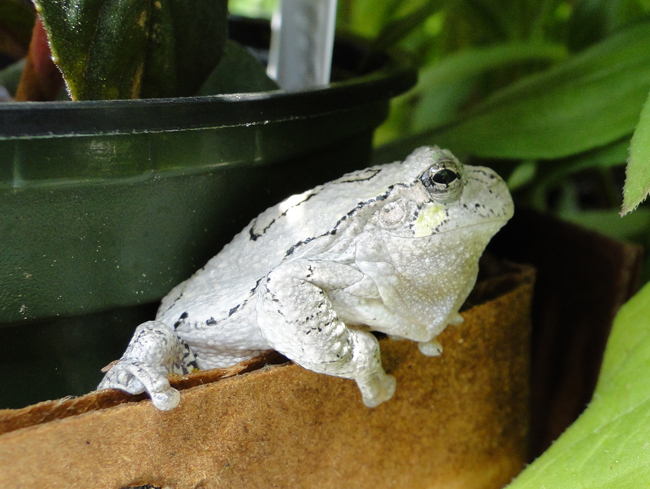
Each of the 16 species of frogs and toads in New Jersey has a unique vocalization or “call” that can be heard during their mating season.
Here’s a list and call quiz of the Frogs in New Jersey:
Eastern Spadefoot (Scaphiopus holbrookii)
American Toad (Anaxyrus americanus)
Fowler’s Toad (Anaxyrus fowleri)
Northern Cricket Frog (Acris crepitans)
Pine Barrens Treefrog (Hyla andersonii)
Green Treefrog (Hyla cinerea)
Gray Treefrog (Hyla versicolor)
unknown gray treefrog species (Hyla chrysoscelis/versicolor)
Cope’s Gray Treefrog (Hyla chrysoscelis)
Spring Peeper (Pseudacris crucifer)
New Jersey Chorus Frog (Pseudacris kalmi)
American Bullfrog (Lithobates catesbeianus)
Carpenter Frog (Lithobates virgatipes)
Green Frog (Lithobates clamitans)
Wood Frog (Lithobates sylvaticus)
Southern Leopard Frog (Lithobates sphenocephalus)
Pickerel Frog (Lithobates palustris)
The Amphibians that are listed as Endangered or Threatened in New Jersey:
Endangered Amphibians
Salamander, blue-spotted – Ambystoma laterale
Salamander, eastern tiger – Ambystoma tigrinum
Treefrog, southern gray – Hyla chrysocelis
Threatened Amphibians
Salamander, eastern mud – Pseudotriton montanus
Salamander, long-tailed – Eurycea longicauda
Treefrog, pine barrens – Hyla andersonii
Volunteers participating in the CAMP project conduct roadside surveys (after dusk) for calling amphibians along designated routes throughout the state. Each 15-mile route is surveyed three times during the spring (March, April & June), during the given four week period. Each route has 10 stops, where you stop, listen and record for 5 minutes. A structured protocol is followed to determine which nights to survey, how long to survey, which species are calling, and how to estimate the total number of individuals calling at each site. All volunteers receive a Calls of NJ Frogs and Toads, CD with which to familiarize themselves with the calls.
The results of these surveys will provide ENSP (Endangered and Nongame Species Program) and the United States Geological Survey with valuable data on the calling amphibian populations in New Jersey. Because each route will be surveyed at the same time and for the same amount of time, routes can be directly compared within a given year and between years. This allows for trends in populations to be identified over time and if needed steps may be taken to protect these populations in the near future.
— Larissa Smith, Biologist/Volunteer Manager, Conserve Wildlife Foundation of NJ
By: frogs are green,
on 6/12/2014
Blog:
Frogs Are Green
(
Login to Add to MyJacketFlap)
JacketFlap tags:
Brazil,
Environmental Books,
biodiversity,
Learn about Frogs,
How You Can Help,
Children and Nature,
Environmental Health,
rainforest,
Frogs and the Rainforest,
People Helping Frogs and Toads,
Chemicals in the Environment,
Frog People,
Read about Frogs,
Climate change and frogs,
Rainforest Frogs,
Frogs in Film,
Teaching Kids about Frogs,
Climate change and the Environment,
wildlife conservation,
Eco Interviews,
Environmental Programming TV and Film,
Sustainable Choices,
brazilian rainforest novel,
environmental book,
Jabujicaba,
Jabujicaba the book,
Jabujicaba the film,
olympics brazil,
Rosa da Silva,
voices for nature,
world cup brazil,
Add a tag
When was your organization founded? Please tell us a bit about its mission, goals…
Jabujicaba the book was published as an e-book at the end of April 2014. The paperback version is coming out this month. Behind it is an idea. Literally a ‘novel’ campaign.
On June 2nd 2014 the not-for-profit company Voices for Nature Limited was incorporated. This takes the campaign forward beyond the life-span of the book.
The people working on this creative project are young and green and Indie… but the ideas behind all this are long in the tooth.

What is your educational background and what led to creating this organization?
I am half German and half English. I grew up always on the move. I have lived in many different countries, including the US where both of my children were born. I speak lots of different languages. I would say I grew up with strong feelings for nature and none for national affiliations.
I studied Modern and Medieval Languages at Cambridge University (Spanish and German). It helps to explain my love for magic realism – Garcia Marques, Isabel Allende – Latin American authors – and German writers like Kafka and Brecht and socialist political art eg: George Grosz and Kaethe Kollwitz.
I worked in the environmental area for many years, with a professional background in policy, communications and campaigning. I was involved in the early days when social/human rights, economic and environmental agendas were merged into ‘sustainability’ – an unimaginative word. I have worked in many countries including Brazil and Africa.
Politically, I believe in intervention in the markets for the good of others. I think a civilized society needs to ensure fair and equal outcomes, not just opportunities (which we know not everybody is able to take advantage of). I believe people must always be intellectually curious and be free to question. I believe in activism and not turning a blind eye or the other cheek. I believe in courage. In the separation of church, judiciary and state.
Over the decades there has been no real progress on climate change or conservation. Climate change continues on the up and so does species extinction. Something is clearly not right about how we are trying to tackle these problems – we know so many facts, we can measure the path we are on and predict where we are going. As a species, human beings need to reconnect with all living creatures and realise our inter-dependence.
I think we can find the right path by re-engaging people emotionally so they feel part (and not in charge) of the natural world.
That is the impulse behind Jabujicaba the book and setting up Voices for Nature. But it is not just a feeling, it is a process of political engagement (with a small ‘p’).
What are some challenges you have faced and how did you deal with them?
Pursuing fairness is a huge and continual challenge in everything I have done in my varied professional career. I was always standing up and arguing with ‘authority’ whether it was with a teacher at school or bosses at work.
Being heard in all the noise of a global market place, which is a Babel, is a big challenge.
The only way forward is to keep repeating yourself and remembering core values and the goal ahead. But you can’t get to where you are going alone in life. You need the help of others. You need to inspire and lead and to do that you need to be empathetic and kind.
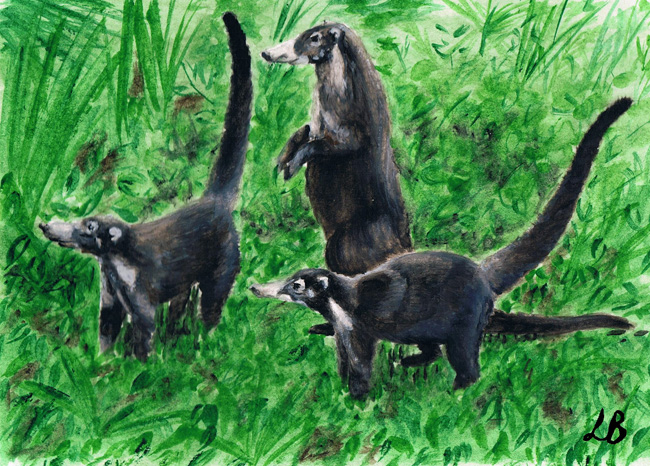
What can people do to help? Donate, and contribute to your cause? Other ideas?
I don’t want the interview to be about selling an idea or a project. It is for people listening to ask their own questions and maybe find some of their answers are aligned with mine. Then they might want to find more about what we are doing and help. They could maybe read the book. It has had good reviews.
How do you reach your targeted audience? Is it through your website, advertising or social media or another route? Which is most effective and why?
All possible routes are tried and taken, although we are trying to work bottom-up, Indie in everything. We wouldn’t say ‘no’ though if Harrison Ford stepped in to help our ambitions for a green Indiana Jones film! Sometimes ‘top down’ or celebrity endorsement can help you to get where you are going (although it is not without its dangers). Certainly we are using social media and word of mouth.
How do you keep the audience engaged over time?
By being happy, having fun, with lots of variety. Everything we do also has to ring an inner chord with the target audience of what really matters, the meaning of our existence, not just our individual life. Jabujicaba is not about simply ‘entertainment.’ Through our website we hope to engage people in other areas of their life – to campaign or to study or volunteer – or even just to take their children to the zoo but with a changed heart.
Tell us about your events around the world and some of the campaigns you have started.
When we made Jabujicaba the book available as a free download to test the audience, we found there was interest all over the world. About 700 copies were downloaded in 5 weeks.Take up is a lot less now, it costs a couple of dollars… We are still at the beginning of our journey.
Our campaigns, if you can call them such, involve around engaging with the books various stakeholders through interviews which explore the relationship between fact and fiction in the book. For instance, in the area of anthropology, with an anthropologist from Oxford University. Or in politics, with a green politician who did a ‘prequel’ meeting one of the characters in my book as a young man. Marco, who is the president of Brazil.
The focus of these interviews has been local and in the UK. We have tried to engage a little in the US, so far without success. It is hard not being there and time constraints mean you stay close to home.
Also the book is in English at the moment which restricts its target audience.

What is in the works for the future? What haven’t you yet tackled, but will want to do soon?
We are working on Jabujicaba the film and progressing step by step. Jabujicaba as a ‘novel’ campaign is timed to coincide with the World Cup and Olympics in Brazil. After that, we plan Voices for Nature to kick in with our film initiative. Through film we will reach a much larger audience with our messages.
Longer term, we would like to fund and reward young people’s creative projects for rainforest conservation, using royalties from the book/film – a bit like Sophie’s World – and grow to a forest (metaphorically and literally).
Bonus!
Jabujicaba is about diversity in our own societies too – and social justice. We need to tackle these issues too.
All on www.jabujicaba.net – but also @ArchieAiredale (my dog!)
By: frogs are green,
on 5/31/2014
Blog:
Frogs Are Green
(
Login to Add to MyJacketFlap)
JacketFlap tags:
Eco Interviews,
sustainable products,
argan oil,
championing education,
ethically sourced,
farm to people,
India,
South Africa,
New Mexico,
organic,
Morocco,
NOFA,
shea butter,
Ghana,
Northeast Organic Farming Association,
Kiroja,
natural products,
Raphael Marius,
socially conscious,
wild harvested,
women run co-ops,
women's empowerment,
How You Can Help,
Environmental Health,
Add a tag
When was your organization founded? Please tell us a bit about its mission, goals…
I started Kiroja in July of 2010. However, the idea of starting something like Kiroja began to take root in sometime in 2000. In fact, I think I originally purchased the domain name around that same time. However, it wasn’t until an injury I sustained while visiting Morocco, that I really started to become more serious about the idea. It still took two more years before I did anything about it.
As far as our mission is concerned, Kiroja is committed to creating quality natural products, supporting women’s empowerment, entrepreneurship, and championing education in its many forms. As an organization, we source our products from women run co-ops and organizations that support women’s empowerment. In support of entrepreneurship, we have donated capital equipment to help small enterprises take the next step in their development. As individuals, we have volunteered our time to organizations and schools as near as your local elementary school, to schools and organizations in South Africa.

What is your educational background and what lead to creating this organization?
I have a bachelor’s degree in management and a master’s degree in international education. As I mentioned earlier, the idea of something like Kiroja began way back in the year 2000. While recovering from the injury I had sustained in Morocco, I had time to think about what I wanted to do with the rest of my life. This led to my graduate pursuits and trips to Ghana, New Mexico, and India to meet with women operated cooperatives and partnerships.
What are some challenges you have faced and how did you deal with them?
A major challenge we faced early on was related to quality control. The sources that we deal with don’t have sophisticated machinery or delivery systems. As a result, we would often receive products, like soap that varied in size and shape. Or prepackaged products were also not in great shape when they arrived. Changes in temperature during the shipping process caused leakage and other issues. Since the co-ops were not around the corner, or even in my home country. It wasn’t easy returning damaged items for new ones. Also, what was the guarantee that the new items would be in any better shape? There was another issue. I didn’t want to put a hardship on the women who ran the co-ops. They couldn’t be expected to constantly exchange damaged product for free. I actually had to put the company in mothballs for a bit to try and solve the problem. At one point, I almost decided to abandon the project and move on to something else.
It may sound weird, but it wasn’t until the middle of last year that I came up with a solution: formulate and package the products in the states. I worked with a designer to create a logo and labels. I switched from plastic containers to amber glass for our butters. I learned as much as possible about Shea Butter (both East and West), Argan Oil, product formulating, and a host of other things related to natural body care.
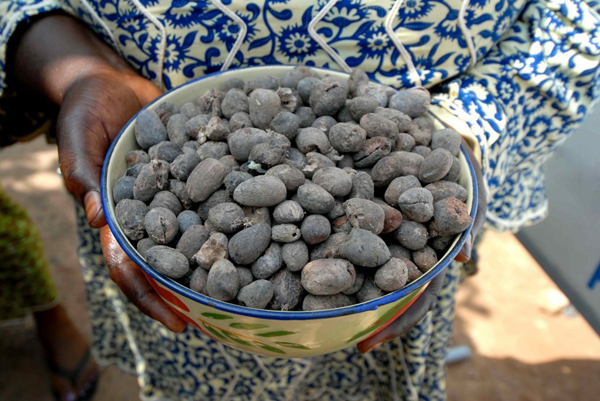
What can people do to help? Donate, and contribute to your cause? Other ideas?
People can help in many ways. Obviously, one way is to purchase our products. The more we sell, the more we can order from our sources. However, people can also help by volunteering their time to organizations that support education and women’s empowerment. One of the issues that is very important to me and formed the basis for my thesis research is getting men involved in preventing sexual and gender based violence.
How do you reach your targeted audience?
We do this in various ways. We take advantage of vending opportunities, like the Green Festival that just took place in April on Pier 94 in New York. We are on Facebook, Twitter, and Pinterest. We also advertise in magazines like NOFA (Northeast Organic Farming Association). We also have our company website, Kiroja.com. You can also find our products in several NY and NJ stores. A couple of the stores that carry our products are actually organic farms.
Is it through your website, advertising or social media or another route? Which is most effective and why?
I think the best way has been word of mouth and when I actually get to talk to a potential customer. In those situations, I’m able to answer any questions they may have and talk about the quality of our products and our mission. This takes time. Although people are familiar with Shea butter, Argan Oil, and other products, They don’t always know the difference in quality. In some cases, what they have been buying may not even have been Shea Butter.
How do you keep the audience engaged over time?
What I try to do (though I’m not always consistent) is create blog posts and updates on Facebook. We notify our customers of upcoming events and opportunities. We also ask some of our customers to try samples of new products we are planning to launch.
http://www.kiroja.com
https://www.facebook.com/pages/Kiroja/1418986274987173
https://twitter.com/Kirojashea
http://www.pinterest.com/kiroja/
By: frogs are green,
on 5/23/2014
Blog:
Frogs Are Green
(
Login to Add to MyJacketFlap)
JacketFlap tags:
north carolina,
alternative energy,
People Helping Frogs and Toads,
Chemicals in the Environment,
chemical contamination and fracking,
Fracking,
wildlife conservation,
chemicals in environment,
Energy Moderization act,
protecting water,
Add a tag
North Carolina Republican Lawmakers Push For A Bill to Give Jail Time To Anyone Who Discloses Chemicals Used In Fracking Operations.
Guest post by Wes Deyton, Wildlife Photographer and Activist
 Nine Republican lawmakers have co-sponsored a bill called the Energy Modernization act. This bill is coming up for a vote in the Senate. The Energy Modernization act will make it a class one felony to disclose the chemicals involved in the fracking process. The Energy Modernization act, if passed, would require companies involved in fracking to submit a list of their chemicals to the state geologist, who will keep the list locked away in case of accident or emergency.
Nine Republican lawmakers have co-sponsored a bill called the Energy Modernization act. This bill is coming up for a vote in the Senate. The Energy Modernization act will make it a class one felony to disclose the chemicals involved in the fracking process. The Energy Modernization act, if passed, would require companies involved in fracking to submit a list of their chemicals to the state geologist, who will keep the list locked away in case of accident or emergency.
Under the Energy Modernization act, unauthorized disclosure of the chemicals involved in fracking can result in up to 1 year in prison, or community service, depending on a person’s previous criminal record.
From BillMoyers.com: The disclosure of the chemicals used to break up shale formations and release natural gas is one of the most heated issues surrounding fracking. Many energy companies argue that the information should be proprietary, while public health advocates counter that they can’t monitor for environmental and health impacts without it. Under public pressure, a few companies have begun to report chemicals voluntarily.
North Carolina has banned fracking until the state can approve regulations. The bill introduced Thursday, titled the Energy Modernization Act, is meant to complement the rules currently being written by the North Carolina Mining & Energy Commission.
Fracking is controversial method of extracting oil and natural gas from rock, deep within the earth. Fracking uses high pressure water sand gravel and chemicals to extract the natural gas from between layers of rocks.
Fracking has been blamed for contaminated ground water, birth defects, and cancer. All this secrecy begs the question… Is the Energy Modernization act about protecting trade secrets or preventing a public outcry, if the public found out what kind of chemicals will be used at fracking sites in North Carolina?
More information can be found at this link: HuffPost Green – North Carolina Fracking Bill.
By: frogs are green,
on 5/22/2014
Blog:
Frogs Are Green
(
Login to Add to MyJacketFlap)
JacketFlap tags:
Learn about Frogs,
Meet the Frogs,
How You Can Help,
Children and Nature,
People Helping Frogs and Toads,
Frog People,
Read about Frogs,
Creating a Wildlife Friendly Backyard,
strawberry poison frog,
A-Z Frogs,
central america frogs,
Dendrobates pumilio,
dream of frogs,
frogs and strawberries,
Oophaga pumilio,
strawberry poison dart frog,
toad in strawberry patch,
Add a tag
Last night I had a dream about a frog. Not unusual for me, right?
In the dream, I was lifting a strawberry out of a container and I see a little frog upside down. Not alive, I’m afraid.
This morning I searched for frogs and strawberries and discovered that it’s not uncommon for frogs to be seen in strawberry patches. Someone had posted a question online about whether the toad frequenting her garden was eating the strawberries. The frog was not eating the fruit, but the bugs in the garden. Most likely the bugs were nibbling on the strawberries. (I think I see a children’s storybook in the making.)
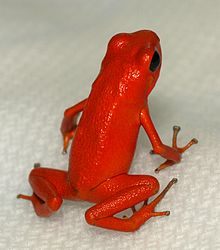 Also in my search, the Strawberry Poison Dart Frog came up, so here’s a photo and a bit about them.
Also in my search, the Strawberry Poison Dart Frog came up, so here’s a photo and a bit about them.
From Wikipedia – Strawberry Poison Dart Frog:
The strawberry poison frog or strawberry poison-dart frog (Oophaga pumilio or Dendrobates pumilio) is a species of small amphibian poison dart frog found in Central America. It is common throughout its range, which extends from eastern central Nicaragua through Costa Rica and northwestern Panama. The species is often found in humid lowlands and premontane forest, but large populations are also found in disturbed areas such as plantations.[1] The strawberry poison frog is perhaps most famous for its widespread variation in coloration, comprising approximately 15–30 color morphs, most of which are presumed to be true-breeding.[2] O. pumilio, while not the most poisonous of the dendrobatids, is the most toxic member of its genus.
By: frogs are green,
on 5/1/2014
Blog:
Frogs Are Green
(
Login to Add to MyJacketFlap)
JacketFlap tags:
Photographing Frogs and Toads,
A-Z Frogs,
frog eyes,
frog hearing,
How Frogs Hear,
How Frogs See,
Nictitating membrane,
Scientist Peter Narins,
Spring Peeper,
Tapetum,
Tympanum,
video frog calling,
Learn about Frogs,
frog calls,
Frog People,
Noise Pollution and Frogs,
American bullfrog,
Teaching Kids about Frogs,
Add a tag
Guest post by Wes Deyton
How Frogs See
Frogs, due to the positioning and design of their eyes have nearly a 360 degree view. This makes up for the fact that they are not able to turn their head and look behind them like other animals can. Frogs, with their nearly 360 degree of field of view, make it difficult for predators to sneak up on them. Frogs also are unable to move their eyes within their eye sockets like humans and other animals can. This causes a Frog to have to turn his head to line up with it’s prey.
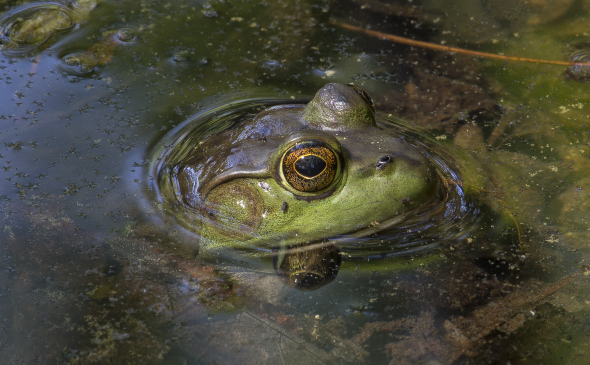
Frogs cannot see while they are attacking prey, so they must have their prey lined up when they go in for the strike. They are unable see their prey while they are making a strike, because when their sticky tongue comes out to snatch up an insect, their eyes retract into the top of their head.
Frogs are near-sighted and they do not see very well at a distance. Their eyes are extremely sensitive to movement, so if a frog’s prey does not move, they will not detect it. They also have excellent night vision, due to a mirror like layer in the back of their eye called a Tapetum. The Tapetum helps frogs reflect and collect ambient light between the back of the eye and the frog’s cornea. Frogs also use their eyes in a rather interesting way. They are unable to swallow like humans and other animals, so they actually push their eyes down into their head to push their food into their stomach.
Frogs eyes come in all different colors, from copper to bronze, gold to silver, and orange to red, like the Red-Eyed Tree Frog. They have three different eye lids. The third eye lid is the most interesting which is a clear membrane, and is called a Nictitating membrane, and this eye lid helps the frog to see underwater as well as to hide from predators.
How Frogs Hear
If you have ever been outside on a warm night you know just how loud Frogs and Toads can be. Male Frogs and Toads call to attract females. Below is a video of an American Toad calling to attract a mate.
You can see in the video, a Toad’s eardrum is the circular indention behind their eyes. You can also tell from the video, this toad calls quite loudly. Frogs and Toads are able to call at upwards of 90 decibels. They have quite sensitive hearing, so the question is, how do they not damage their eardrums or deafen themselves with their loud calls?
Scientists have discovered that Frogs hear with both their ear drums and their lungs and a pressure system builds inside the Frog that minimizes vibrations from internal noises made by the frog.
To further elaborate on this, I need to talk about how a frogs ear drum works. A frog’s ear drum is called a Tympanum and works in very much the same way that our human ear drums work. A frog’s ear drum, just like a humans ear drum, is a membrane that is stretched across a ring of cartilage like a snare drum that vibrates. There is rod that is connected to the ear drum, which vibrates by sounds that come at the frog. That sound is just pressure waves. The rod sloshes around in the inner ear fluid, which causes microscopic hairs to move, which send signals to the frog’s brain for interception. A frog’s ear lungs also vibrate when sound waves come toward it, although they are less sensitive than the frogs ear drum.
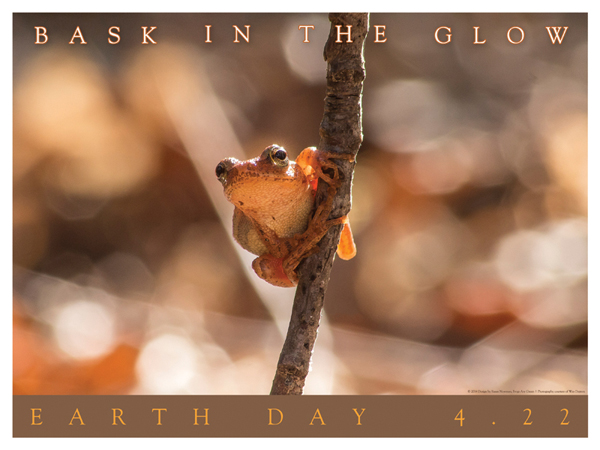
Some frogs, like the Spring Peeper, pictured, have a call that is so loud, they can be heard up to one mile away. These creatures are so noisy, it is a wonder that they do not hurt their ears and deafen themselves with their own calls. Frogs have a very clever method of making sure that their own loud calls do not hurt their own hearing.
In 1988, Scientist Peter Narins, who is a professor at UCLA of Physiological Science, found that frogs have an internal pressure system, a closed air loop, that keeps the frog’s own ear drum from vibrating excessively from its own call. Scientists have found that pressure builds between their lungs and ear drum, which then equalizes the pressure between the inner and outer surfaces of the frogs ear drum, which greatly cuts down on the vibrations that a frog experiences, from their internal calls. It is also believed that another purpose of the closed loop pressure system, is so Frogs can detect the direction a sound is coming from with its lungs, that way they can escape danger while calling. Being in the vicinity of a frogs calling can subject a human to sounds so loud, that are upwards of 90 dB, which can cause discomfort and hearing loss for humans.
Sources: April Holladay: Frogs Can Hear Without Ears. 4/26/2001. Wes Deyton’s blog at Last Mile Photography
By: frogs are green,
on 4/27/2014
Blog:
Frogs Are Green
(
Login to Add to MyJacketFlap)
JacketFlap tags:
Earth Day,
Learn about Frogs,
Children and Nature,
frog exhibits,
Frog Conservation,
Frogs Are Green contests,
People Helping Frogs and Toads,
Frog People,
Amphibian habitat loss,
Climate change and frogs,
Frogs in Film,
Deforestation and amphibians,
chytrid fungus,
Save the Frogs Day,
frogs as bioindicators,
Chytrid disease,
Kids Art Contest,
Teaching Kids about Frogs,
Frogs Are Green kids' art contest,
Climate change and the Environment,
Green Dream,
Eco Interviews,
Environmental Programming TV and Film,
Add a tag
We all have something we’re passionate about, and it’s not always easy to get others to share our enthusiasm, but yesterday, Jersey City came out to learn about frogs, amphibians and enjoy the Earth Day / Save The Frogs Day event.
As the event began, we set out all the delicious, healthy food (some came from vegan, organic, gluten-free baker Chef Camillo Sabella), the wine and beverages, the day’s musical guests, The Gully Hubbards began to play. People started streaming in. Artists, nature-lovers, neighbors, parents and children (some who take Saturday morning art classes at the Distillery Gallery) and everybody would say how great the space was, the music sounded, and how amazing the art was.
At about 5 pm, a reporter from Jersey City 1 TV (JC1TV) arrived and interviewed me about Frogs Are Green, what the Green Dream is about, and why it’s so important to save frogs. Then Mayor Steven Fulop arrived and we took some photos, and talked together about frogs. He was quite informed on the topic, so the discussion was very good. Then the reporter captured the Mayor and I discussing frogs and why we must save them. The Mayor moved around the gallery looking at the art, talking with others and the children also. Then we moved to the back end of gallery along with the two curators, Kristin DeAngelis and Gabriel Pacheco and the Mayor spoke to the crowd about frogs and amphibians, and the three of us spoke as well. The Mayor gave us proclamations, and we gave the Mayor gifts. A painted flowerpot (with flowering plant) by one of the children who is enrolled in the Saturday classes at the gallery, a Green Dream t-shirt, and one of the most recent Earth Day posters from Frogs Are Green, illustrated by Sylvie Daigneault. It was so fantastic to see a crowd so into this.
Afterward, there were two environmental speakers, Michelle Anne Luebke, an instructor at CUNY/environmentalist and Laura Skolar of Jersey City Parks Coalition, who spoke. There were so many children at yesterday’s event, some who sat on the floor in a circle and were drawing with chalk and crayons. We did the drawing of the raffle contest and the winner was announced, but wasn’t there, so he will be notified. One lucky child receives a year of art classes at the gallery for free!
The overall harmony of the event was perfect. The people, music, food, and excitement with photographers and TV, made the event a thrill for me and everybody had a fabulous time. There will be many more photos to come (from official photographer, Danny Chong) as well as video of course, but here are a few, so you share in the event’s success.
— Susan Newman, founder, Frogs Are Green
By: frogs are green,
on 4/19/2014
Blog:
Frogs Are Green
(
Login to Add to MyJacketFlap)
JacketFlap tags:
Contests,
Earth Day,
Learn about Frogs,
How You Can Help,
Children and Nature,
frog exhibits,
Frogs Are Green contests,
People Helping Frogs and Toads,
Frog People,
Climate change and frogs,
Save the Frogs Day,
Frog posters,
creative kids,
earth day event,
Kids Art Contest,
Teaching Kids about Frogs,
Frogs Are Green kids' art contest,
Frogs Are Green Photo Contests,
Photographing Frogs and Toads,
Green Dream,
A-Z Frogs,
Earth Day 2014,
Mayor Steven Fulop,
Sensational Country Blues Wonders,
distillery gallery jersey city,
chef camillo sabella,
City of Jersey City,
distillery gallery,
frog artwork,
gia gelato,
green dream art exhibition,
green dream jersey city,
jersey city gallery,
Jersey City Parks Coalition,
Pershing Field Garden Friends,
save the frogs day event,
the gully hubbards,
The Village Jersey City,
Add a tag
In the Spring of 2009, when Frogs Are Green was just an idea, I had a dream, and that dream is coming true.
My dream is to do all that I can to bring awareness within my community and around the world to help save frogs and amphibians.

This coming Tuesday, April 22, is Earth Day and we’re having the first of two celebrations, here in Jersey City! The Distillery Gallery and Artspace has partnered with Frogs Are Green to showcase hundreds of artworks by children 3-12 from more than 27 countries. Green Dream International Children’s Earth Day Exhibition is on display April 5-27 and visitors are streaming in, either as they pass by or riding over on their bicycles.
On the 22nd of April, join us between 7-10 pm for a little wine and food with our musical guests, The Sensational Country Blues Wonders.
Saturday, April 26th, is Save the Frogs Day and this will be the first big STF Day event we’ve coordinated here in Jersey City. Join us from 4-7 pm with musical guests, The Gully Hubbards, as well as guest speakers: Mayor Steven Fulop, Laura Skolar of the Jersey City Parks Coalition, and Michelle Anne Luebke, instructor at CUNY and environmentalist. Chef Camillo Sabella is bringing his delicious gluten-free, vegan, organic treats and Gia Gelato is bringing her yummy gelato!
Bringing awareness to Jersey City, one community group at a time
I have connected with Jersey City in a multitude of new ways.
Last week, I spoke at The Village Community Association, which is a section of downtown Jersey City, and this past week I spoke to the Pershing Field Garden Friends (in my own neighborhood), and enjoyed hearing about what both groups are doing!
I have also connected with the visual coordinator for Jersey City public schools as well as teachers at the Learning Community Charter School where they study frogs and amphibians as a part of their curriculum.
Each time someone asks “What’s happening to the frogs?” I know my work has just begun.
Talking with different people from these different groups has given me ideas of ways to build even more awareness in the coming months and years. I’ll be looking to bring the Green Dream to other cities, schools and galleries as a traveling exhibit.
The 2014 Frogs Are Green children’s art contest as well as the photography contests (Frogs in the Wild and Backyard Frogs, which are open to frog lovers of all ages), will open September 2, 2014 and I expect Jersey City to lead the USA as the largest contributor of artwork and make us all proud.
Happy Earth Day and Save The Frogs Day, to all.
— Susan Newman, founder, Frogs Are Green
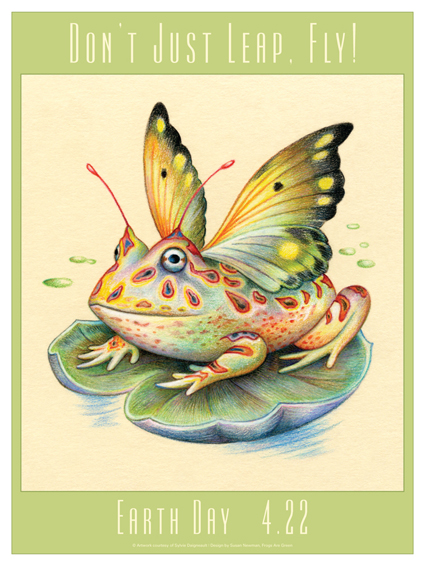
By: frogs are green,
on 4/14/2014
Blog:
Frogs Are Green
(
Login to Add to MyJacketFlap)
JacketFlap tags:
Learn about Frogs,
How You Can Help,
Life Cycle of Frogs,
People Helping Frogs and Toads,
Frog People,
Climate change and frogs,
Frog hibernation,
Photographing Frogs and Toads,
Bartholomew the bullfrog,
bullfrog rescue,
bullfrogs in Massachusetts,
frog hybernation,
mid-winter frog rescue,
Add a tag
The story continues with Jack Stearns, a scientist and meteorologist, who had rescued a bullfrog (Bartholomew) in the middle of Winter.
We released Bart back to his pond a little while ago.
Enclosed are pictures of him in his carrier, sitting on the beach, and where he dove into.
I was going to switch to video after the second picture, but before I could he took a three foot leap into the pond and swam very strongly, diving into the debris on the bottom in the last picture. We were both surprised at how strong he was. I figured after a winter of hibernating he would just slowly walk into the water.
The good news from all this is that one can successfully hibernate frogs over the winter time. We had him for 3 months and 3 days and as you can see, he was none the worse for wear.
Our next project is to get a couple of bullfrog tadpoles from our local pond and put them in the tank and watch their transformation into frogs. I did this as a kid. My wife has never seen it so she thinks it would be cool to watch.
— Jack Stearns
Here is the original post when Bart (the bullfrog) was found: Mid-Winter Bullfrog Rescue
Below are a few photographs Jack kindly shared. (Good Luck Bart, we’re excited your journey continues!)
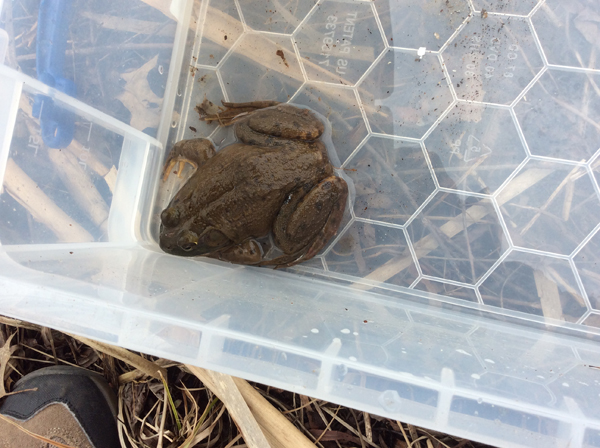

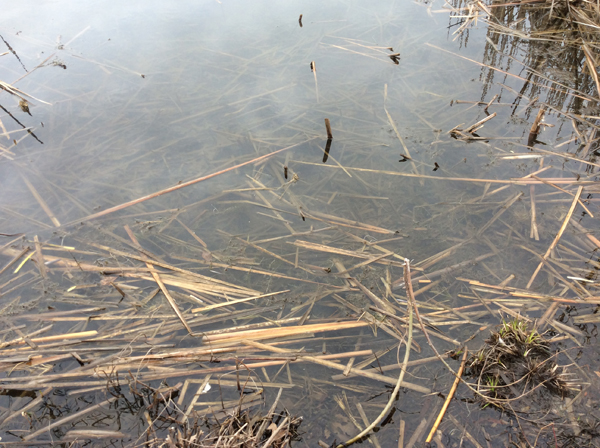
View Next 25 Posts









































































